Myeongdong Market in Seoul is a vibrant culinary hub, boasting over 200 vendors that transform evening strolls into extraordinary gastronomic adventures. It offers a wide array of sweet and savory street foods, from unique ice creams like marshmallow and fish-shaped bungeoppang to traditional favorites like spicy fish cakes and dumplings. Visitors can also enjoy innovative takes on classic dishes, such as Korean corn dogs with stretchy mozzarella and diverse fried chicken preparations, alongside refreshing fruit cups and a variety of substantial options like kimchi roll pork belly and baked whole potatoes. It's wise to bring cash as it's still preferred by many vendors.
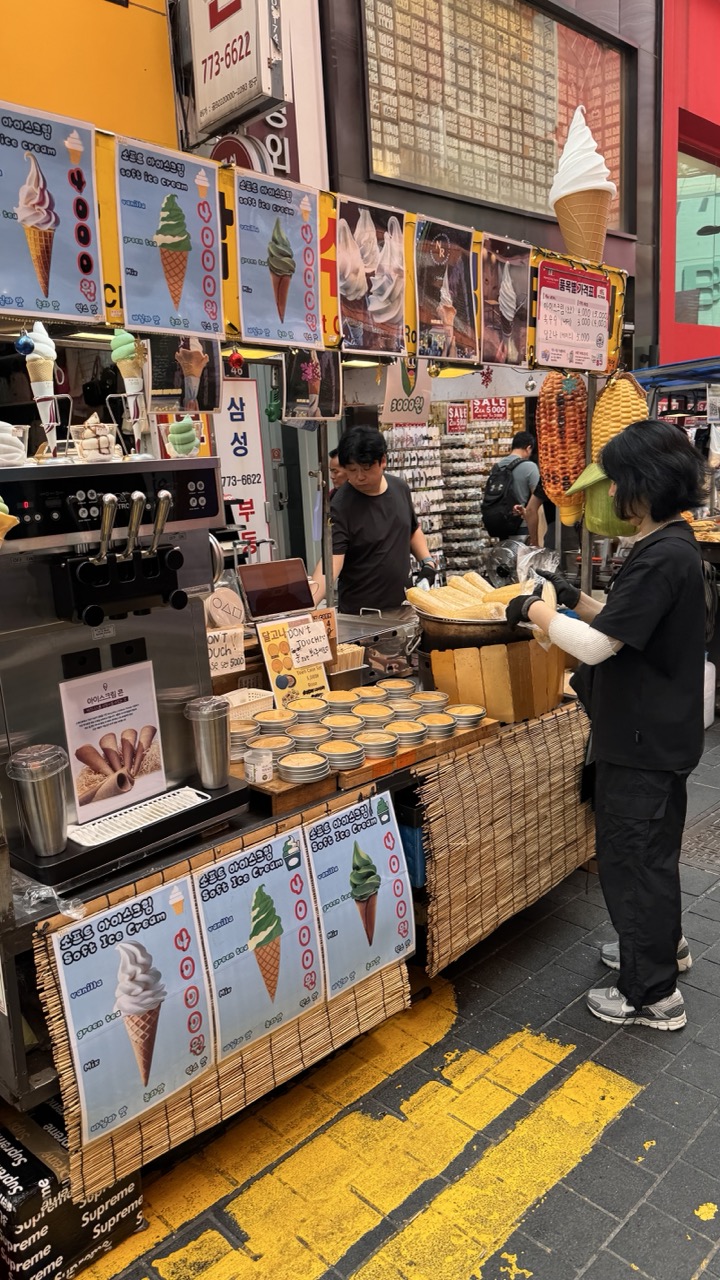

1. Overall Rating (0–10) — 7.0
This photograph captures the vibrant energy of a bustling street food stall, where the sensory overload of colors, textures, and signage creates a vivid sense of place. The scene is rich with cultural detail—Korean text, branded products, and the tactile presence of corn and ice cream—giving it a lively, authentic pulse. While the composition feels slightly crowded, the photograph succeeds in conveying the rhythm of daily life in a busy urban market, balancing documentary realism with visual appeal.
2. Composition (0–10) — 6.0
The frame is densely packed with elements, leading to visual clutter that distracts from the central subject. The diagonal yellow lines on the pavement help guide the eye, but the overlapping signs and objects create a sense of disarray.
3. Lighting (0–10) — 6.5
Natural daylight illuminates the scene evenly, preserving detail across the stall and its surroundings. However, the bright, flat light lacks depth, reducing the dramatic effect of shadows and giving the image a slightly commercial, snapshot-like quality.
4. Color & Tone (0–10) — 7.5
The palette is lively and varied, with bold yellows, reds, and blues from the signage contrasting with the warm browns of the corn and the neutral tones of the pavement. The saturated colors enhance the visual energy, though some signs are slightly overexposed.
5. Creativity (0–10) — 7.0
The image captures a moment of authentic street life with a strong sense of cultural specificity. The layering of signs, products, and activity suggests a story of commerce and community, though the approach is more observational than interpretive.
6. Technical Quality (0–10) — 7.5
The image is sharp and well-focused, with clear details in both the foreground and background. The depth of field is adequate, allowing key elements to stand out while still maintaining context.
7. Emotional Impact (0–10) — 6.5
The photograph evokes a sense of curiosity and warmth, drawing the viewer into the daily rhythm of the marketplace. While it doesn’t elicit deep emotional resonance, it effectively communicates the charm and energy of urban street culture.
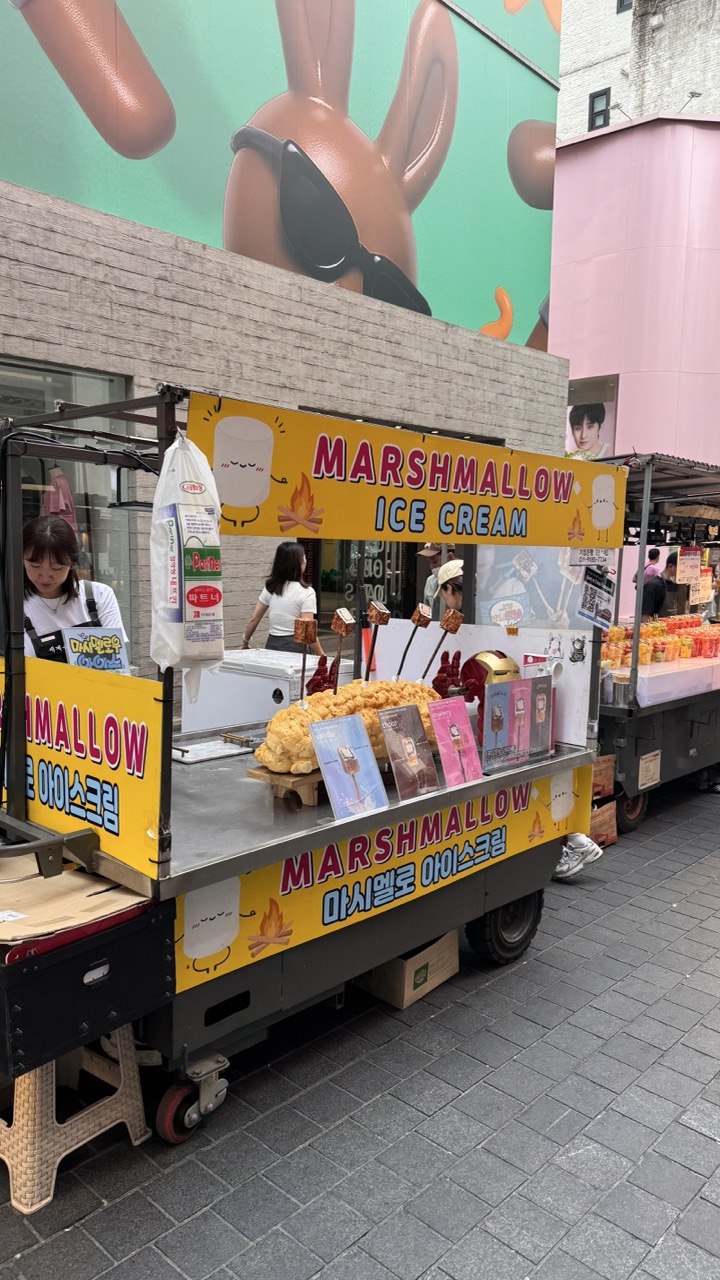

1. Overall Rating (0–10) — 6.0
This photograph captures a vibrant street food scene with playful energy, where the whimsical marshmallow ice cream cart takes center stage. The bold colors and cartoonish branding inject a sense of fun, while the backdrop of a giant rabbit mural adds a layer of surreal charm. However, the image feels slightly overloaded with visual elements, and the casual, snapshot quality tempers its overall aesthetic impact.
2. Composition (0–10) — 5.5
The cart is well-framed, but the composition is slightly cluttered with foreground and background elements competing for attention. A tighter crop would better emphasize the main subject and reduce visual noise.
3. Lighting (0–10) — 6.0
Natural daylight provides even illumination, highlighting the bright yellow signage and the textures of the marshmallows. However, the flatness of the light diminishes depth and shadow, giving the scene a somewhat unremarkable quality.
4. Color & Tone (0–10) — 7.5
The palette is lively and engaging, with the yellow cart, pink building, and green mural creating a vibrant contrast. The colors are saturated and cohesive, contributing to the image’s playful tone.
5. Creativity (0–10) — 7.0
The juxtaposition of a quirky food stall with a giant cartoon rabbit mural offers a unique, whimsical narrative. The choice to photograph this moment captures the essence of urban street culture with a touch of humor and visual delight.
6. Technical Quality (0–10) — 7.0
The image is sharp and clear, with good detail in the signage and textures. The focus is consistent, and the exposure is well-balanced, though the framing limits the overall impact.
7. Emotional Impact (0–10) — 6.5
The photograph evokes a sense of joy and curiosity, inviting the viewer into a lively, sensory-rich street scene. While it doesn’t deeply move, it succeeds in capturing the lighthearted spirit of urban street food culture.


1. Overall Rating (0–10) — 6.0
This image captures the vibrant energy of a street-side ice cream stall, brimming with playful branding and a sense of everyday charm. The colorful display of marshmallow ice creams and whimsical figurines creates an inviting, almost cartoonish atmosphere, though the composition feels slightly cluttered and lacks a clear focal point. While the scene is lively and authentic, the image struggles to balance its visual elements, resulting in a snapshot that feels more documentary than artistic.
2. Composition (0–10) — 5.5
The frame is crowded with text, objects, and signage, creating a busy foreground that distracts from the central figure. The vendor is slightly off-center, and the angled cart edge cuts diagonally across the lower third, disrupting visual harmony.
3. Lighting (0–10) — 6.0
Natural daylight illuminates the scene evenly, but the overhead fluorescent lights on the stall cast a flat, clinical glow that dulls the vibrancy of the colors. The contrast between the bright signage and the shadowed background creates mild depth, but the lighting lacks direction and mood.
4. Color & Tone (0–10) — 7.0
The palette is lively and engaging, with bold yellows, blues, and pinks dominating the signage and ice cream displays. However, the overall tone is slightly washed out, and the color temperature leans neutral, preventing the scene from feeling truly dynamic or atmospheric.
5. Creativity (0–10) — 7.0
The use of playful props and animated branding adds a whimsical, commercial flair that reflects the stall’s personality. The mix of Korean and English text and the quirky character figures suggest a deliberate effort to appeal to both locals and tourists, making the image creatively expressive in its commercial intent.
6. Technical Quality (0–10) — 7.5
The image is sharp and well-focused, with clear details visible in the ice cream machine, signage, and product displays. The camera appears to be steady, and there are no obvious technical flaws like motion blur or noise.
7. Emotional Impact (0–10) — 6.0
The image evokes a sense of nostalgia and delight, particularly for those familiar with Korean street food culture. The cheerful colors and smiling vendor suggest warmth and joy, but the visual clutter keeps the emotional connection from fully resonating, leaving the viewer with a pleasant impression rather than a deep emotional pull.


1. Overall Rating (0–10) — 6.0
This photograph captures the lively energy of a Korean street food stall, where the vibrant signage and bustling activity convey a sense of authentic market life. The scene is rich with cultural detail and narrative potential, though the composition feels slightly cluttered and the lighting flattens the visual depth. With tighter framing and more intentional focus, the image could better convey the warmth and immediacy of the moment.
2. Composition (0–10) — 5.5
The frame includes too much background clutter, pulling attention away from the central vendor and product. A tighter crop would emphasize the interaction between vendor and customer and highlight the signature fish-shaped buns.
3. Lighting (0–10) — 5.0
Harsh overhead lighting creates flat, unflattering illumination, washing out textures and reducing the visual warmth of the scene. The fluorescent glow emphasizes the commercial nature of the space but lacks atmospheric depth.
4. Color & Tone (0–10) — 6.0
The warm golden tones of the buns contrast well with the cooler blues and grays of the stall’s signage and structure. The palette is lively, though slightly oversaturated, giving the image a commercial, almost promotional feel.
5. Creativity (0–10) — 6.5
The image successfully documents a slice of everyday life in a Korean market, blending cultural specificity with a clear subject. The use of multilingual signage and product description cards adds narrative richness and authenticity.
6. Technical Quality (0–10) — 7.0
The image is sharp and detailed, with good focus on the sign and the food. However, the depth of field is shallow, and some background elements are distracting, slightly undermining technical clarity.
7. Emotional Impact (0–10) — 5.5
While the scene is engaging and relatable, the lack of a strong focal point and emotional connection limits its resonance. The viewer is positioned as an observer rather than a participant in the moment.


1. Overall Rating (0–10) — 6.0
This photograph captures the vibrant energy of a street-side mochi stall, where colorful treats and playful signage create a sense of cheerful indulgence. While the scene is visually engaging and full of cultural texture, the composition feels slightly cluttered and the lighting lacks depth, softening the image’s overall impact. The candid nature of the moment gives it authenticity, but it stops short of cinematic polish.
2. Composition (0–10) — 5.5
The frame includes a lot of background detail, which distracts from the central display of mochi. A tighter crop would focus attention on the products and vendor, improving balance and visual clarity.
3. Lighting (0–10) — 5.5
The lighting is flat and diffused, likely due to overhead fluorescent sources and ambient daylight, which flattens shadows and reduces dimensionality. While it clearly illuminates the scene, it lacks warmth or directional drama.
4. Color & Tone (0–10) — 6.0
The palette is bright and playful, with pops of red, yellow, and pastel tones from the mochi and signage. However, the overall tone is slightly washed out, reducing the richness of the colors and giving the image a slightly sterile feel.
5. Creativity (0–10) — 6.5
The scene is inherently creative, capturing a slice of Japanese street food culture with a whimsical, consumer-friendly aesthetic. The use of character-themed labels and colorful displays reflects a strong sense of brand identity and storytelling.
6. Technical Quality (0–10) — 6.5
The image is sharp and in focus, with clean details visible in the food and signage. However, the lack of depth of field and slightly uneven exposure detract from the overall technical refinement.
7. Emotional Impact (0–10) — 5.5
The image evokes a sense of curiosity and delight, especially for those familiar with Japanese desserts. Yet, the busy environment and lack of a clear focal point prevent a deeper emotional connection, keeping the viewer at a distance.


1. Overall Rating (0–10) — 6.0
This image captures a vibrant street food stall in a bustling urban setting, where the colorful signage and neatly arranged mochi offerings create an inviting sense of local charm. The scene feels authentic and lively, though the composition is slightly cluttered by surrounding signage and foreground elements that distract from the central subject. While the photograph successfully conveys the energy of a city street, it lacks a more refined visual focus that would elevate it beyond a simple snapshot.
2. Composition (0–10) — 5.5
The mochi cart is framed centrally but is partially obscured by the surrounding signage and a person in the foreground, creating a sense of visual noise. The diagonal lines of the cart and the building’s architecture provide some dynamism, but the lack of clear leading lines diminishes the image’s compositional strength.
3. Lighting (0–10) — 6.0
The lighting is bright and even, likely from a combination of natural daylight and artificial storefront lighting, which effectively highlights the colors of the mochi and signage. However, the harshness of the overhead lights creates some glare and reduces the depth of shadows, giving the scene a slightly flat appearance.
4. Color & Tone (0–10) — 6.5
The palette is lively and varied, with bold purples, reds, and oranges from the signage contrasting against the neutral tones of the cart and pavement. The colors are vibrant and contribute to the energetic mood, though some tones appear slightly oversaturated, particularly in the neon signs.
5. Creativity (0–10) — 6.0
The image captures a moment of everyday urban life with a sense of authenticity and cultural specificity. While the subject matter is engaging, the execution leans toward documentation rather than artistic interpretation, with little use of creative framing or conceptual depth.
6. Technical Quality (0–10) — 7.0
The photograph is sharp and well-focused, with clean details in the mochi display and signage. The exposure is balanced, and the camera appears to be steady, though the framing and background distractions slightly undermine the overall technical polish.
7. Emotional Impact (0–10) — 5.5
The image evokes a sense of curiosity and mild nostalgia for street food culture, but the emotional resonance is limited by the lack of a clear narrative or human connection. The vendor’s quiet presence adds a touch of intimacy, but the scene remains more observational than emotionally compelling.
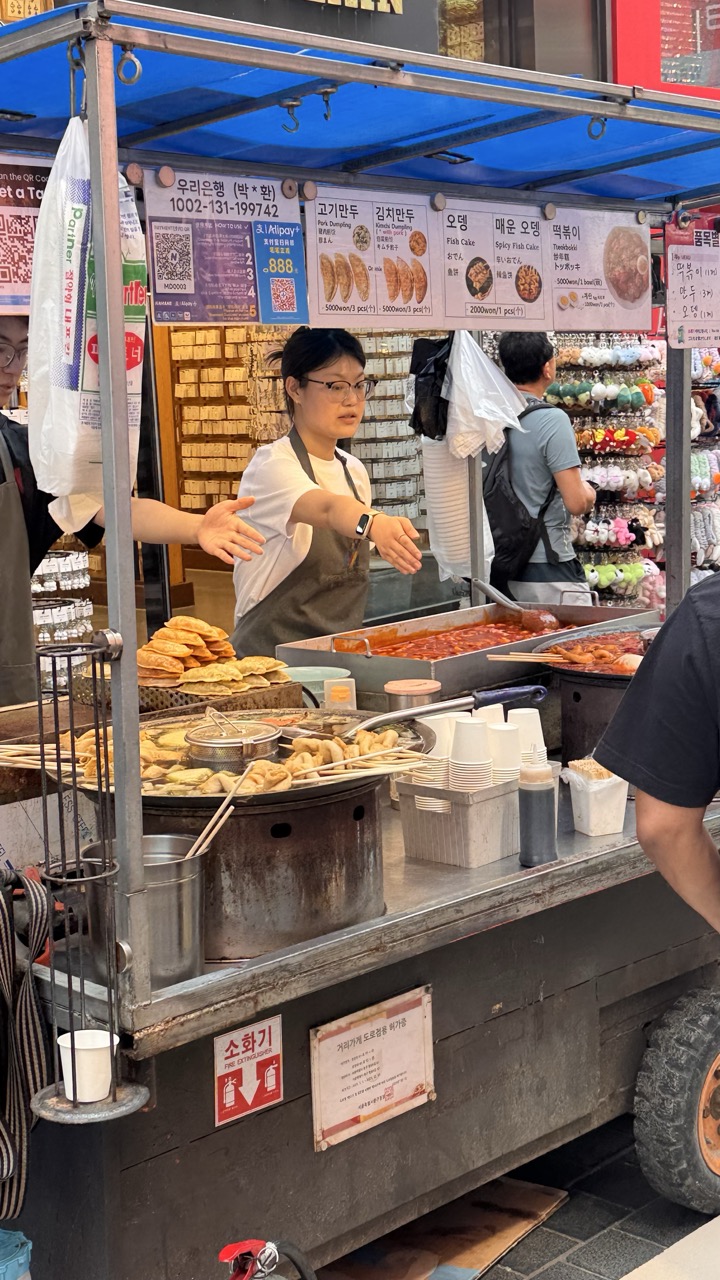

1. Overall Rating (0–10) — 7.0
This photograph captures the vibrant energy of a Korean street food stall, brimming with sensory detail and cultural authenticity. The vendor’s focused expression and the array of sizzling ingredients convey a sense of immediacy and daily rhythm, while the surrounding signage and merchandise add layers of context. Though the scene is slightly cluttered, the image successfully balances documentary realism with visual storytelling, offering a glimpse into the pulse of urban life.
2. Composition (0–10) — 6.5
The frame is filled with activity, creating a sense of depth but slightly overwhelming the central subject. The vendor is well-placed, but the surrounding elements—especially the plastic bags and signage—distract from the focal point. A tighter crop could improve visual clarity and emphasize the action at the counter.
3. Lighting (0–10) — 6.0
Natural daylight illuminates the scene evenly, though the overhead blue canopy casts a cool tone that slightly flattens the image. The shadows under the stall are soft and diffuse, preserving detail without harsh contrast, but the lighting lacks the warmth that would enhance the food’s appeal.
4. Color & Tone (0–10) — 7.0
The palette is rich with the warm browns of fried food, the reds of the sauce, and the blue of the canopy, creating a visually engaging contrast. The color saturation feels natural, with just enough vibrancy to highlight the textures of the food without appearing oversaturated.
5. Creativity (0–10) — 7.0
The image tells a story of everyday commerce with a candid authenticity. The combination of food, language, and urban detail provides cultural specificity, making the scene feel both immediate and deeply rooted in place. The photographer captures a moment that feels lived-in rather than staged.
6. Technical Quality (0–10) — 7.5
The image is sharp and well-focused, particularly on the vendor and the food items in the foreground. Details like the texture of the fried snacks and the clarity of the signage are well-rendered, with no noticeable noise or blur.
7. Emotional Impact (0–10) — 6.5
There’s a quiet warmth in the vendor’s concentration and the familiar rhythm of the stall, evoking a sense of connection to local culture and daily life. While not emotionally dramatic, the image resonates with authenticity and invites the viewer to imagine the sounds and smells of the market.
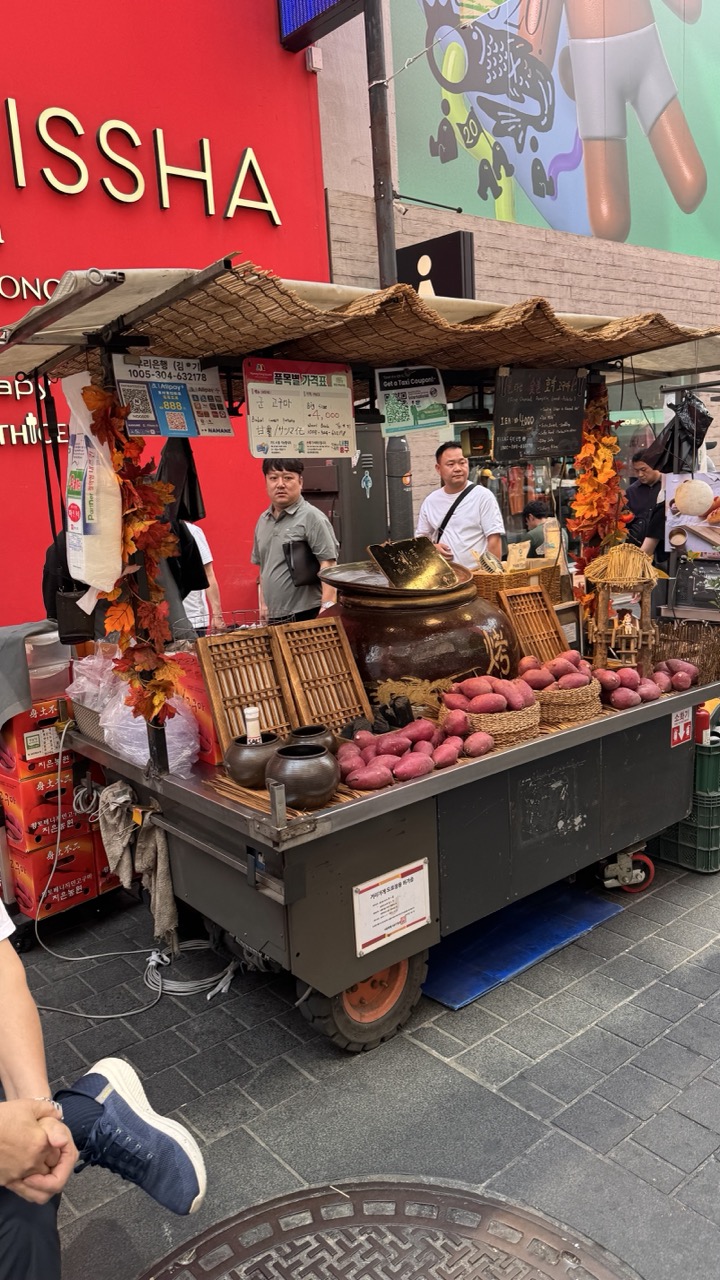

1. Overall Rating (0–10) — 6.0
This photograph captures the lively chaos of a street food stall in a bustling urban setting, where tradition meets modernity in a vibrant display of culture and commerce. The composition is rich with detail and narrative potential, yet it feels slightly overwhelmed by the surrounding elements, which compete for attention. While the scene is visually engaging and full of life, the lack of focus and overabundance of background noise keep it from achieving a more refined aesthetic.
2. Composition (0–10) — 5.5
The frame is crowded and uneven, with the lower-left corner dominated by a foot and manhole cover, creating a visual imbalance. The stall is centered but partially cut off, while the background signage and passersby distract from the main subject.
3. Lighting (0–10) — 6.0
Natural daylight provides even illumination, but the harsh overhead light flattens shadows and diminishes depth. The red storefront sign casts a strong color cast, enhancing vibrancy but also contributing to visual clutter.
4. Color & Tone (0–10) — 6.5
The bold red of the ISSHA sign contrasts sharply with the earthy tones of the stall and the muted pavement, creating a dynamic palette. However, the mix of warm and cool tones feels unbalanced, with the autumnal decorations adding a seasonal warmth that doesn’t fully integrate with the urban backdrop.
5. Creativity (0–10) — 6.0
The image succeeds in documenting a moment of everyday life with authenticity and cultural specificity. The juxtaposition of traditional food preparation against a modern retail backdrop offers a subtle commentary on urban life, though the execution remains more observational than artistic.
6. Technical Quality (0–10) — 7.0
The image is sharp and clear, with good detail in both the foreground and background. Focus is consistent, and exposure is balanced, though the framing and composition limit its overall impact.
7. Emotional Impact (0–10) — 5.5
The scene evokes a sense of place and movement, but the emotional resonance is muted by the visual noise. The viewer is invited to observe, but not deeply engage—there’s a disconnect between the richness of the subject and the way it’s framed.
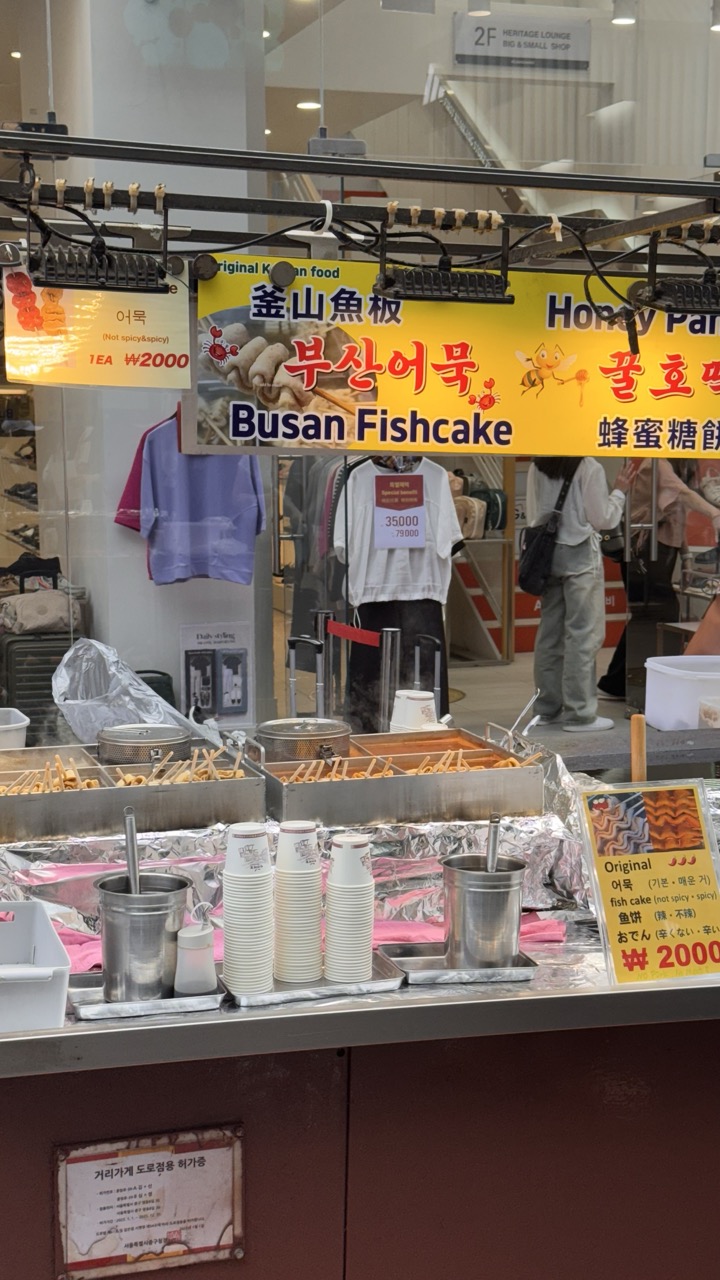

1. Overall Rating (0–10) — 6.0
This image captures the bustling energy of a Korean street food stall, where the vibrant signage and everyday activity convey a sense of cultural authenticity. While the composition is rich with detail and context, it feels slightly cluttered, with too many visual elements competing for attention. The scene tells a story of urban life and culinary tradition, but lacks the visual cohesion to elevate it into a more compelling photograph.
2. Composition (0–10) — 5.5
The framing includes too many distractions—overhead signs, background shoppers, and cluttered counter items—which fragment focus. A tighter crop or clearer subject hierarchy would improve balance.
3. Lighting (0–10) — 6.0
The overhead fluorescent lighting is functional but flat, casting a sterile glow that dulls the scene’s potential warmth. The reflections on the metal containers add minor visual interest but do little to enhance mood.
4. Color & Tone (0–10) — 6.5
The bright yellow sign and red text create a strong focal point, though the overall palette is muted by the surrounding neutral tones. The contrast between the vivid signage and the dull surroundings is effective but not fully leveraged.
5. Creativity (0–10) — 6.0
The image documents a real-world moment with honesty and cultural specificity. While not artistically ambitious, it succeeds in capturing the atmosphere of a typical Korean food market.
6. Technical Quality (0–10) — 7.0
Sharp focus and clear details allow for easy reading of text and identification of objects. The image is technically sound, though compositionally unrefined.
7. Emotional Impact (0–10) — 5.5
The scene evokes a sense of place and routine, but the visual clutter and lack of emotional focus keep the viewer at a distance rather than inviting engagement.
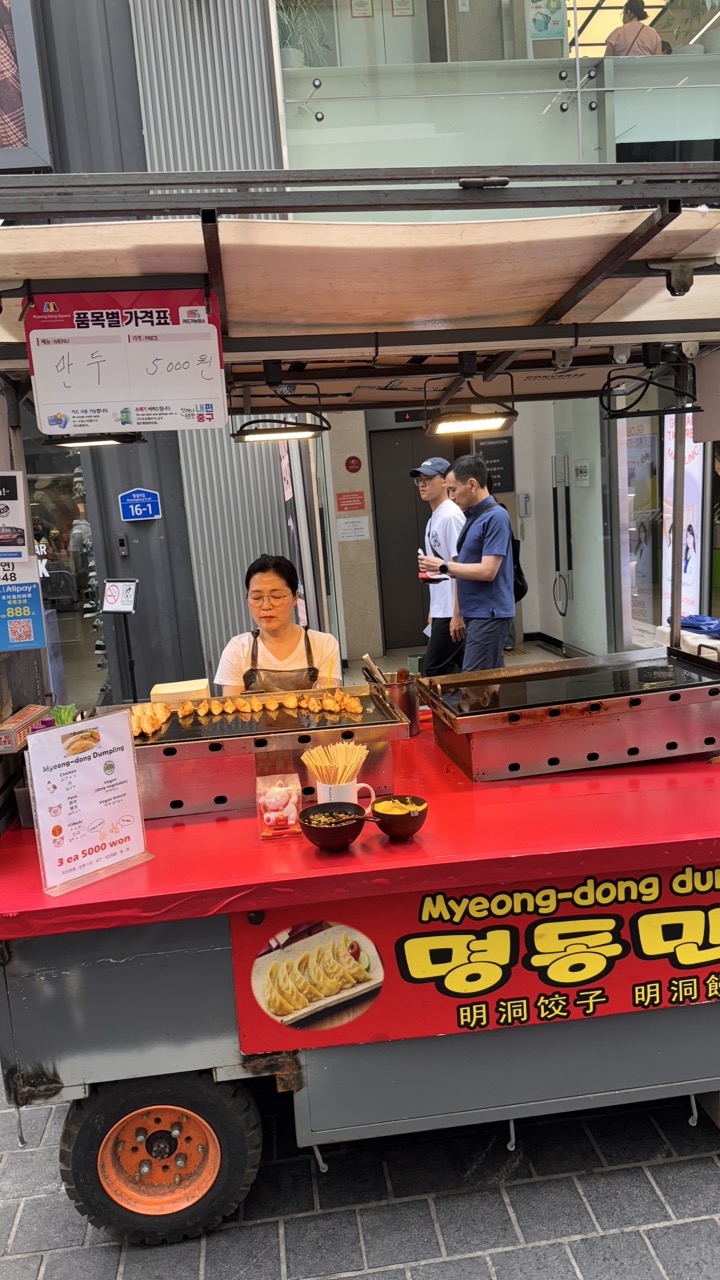

1. Overall Rating (0–10) — 6.8
This photograph captures the vibrant energy of a Korean street food stall, where the bright red cart and sizzling dumplings create an inviting sense of urban authenticity. The scene feels candid and alive, with the vendor focused on her craft and passersby adding a layer of everyday movement. While the composition is slightly cluttered and the lighting is functional rather than artistic, the image succeeds in conveying the warmth and accessibility of a local food culture—its charm lies in its unpolished realism.
2. Composition (0–10) — 6.0
The framing is slightly off-center, with the cart dominating the lower half and the background elements creating visual distraction. A tighter crop focusing on the vendor and food would enhance narrative clarity.
3. Lighting (0–10) — 5.5
The lighting is flat and artificial, typical of an indoor or covered commercial space. While it illuminates the scene clearly, it lacks depth and fails to highlight the textures of the food or the warmth of the moment.
4. Color & Tone (0–10) — 7.0
The bold red of the cart and the warm golden tones of the dumplings create a visually engaging contrast. The color palette is vibrant and culturally resonant, though slightly oversaturated, which diminishes subtle tonal nuances.
5. Creativity (0–10) — 6.5
The image captures a familiar street food scene with authenticity and cultural specificity. While not particularly original in concept, it effectively tells a story of local commerce and culinary tradition.
6. Technical Quality (0–10) — 7.5
The image is sharp and well-focused, with clear details on the food, signage, and vendor. The exposure is balanced, though some areas show slight overexposure from the overhead lights.
7. Emotional Impact (0–10) — 6.0
The photograph evokes a sense of everyday life and community, with the vendor’s quiet concentration offering a moment of human connection. However, the lack of dramatic lighting or emotional framing keeps the viewer at a slight remove.
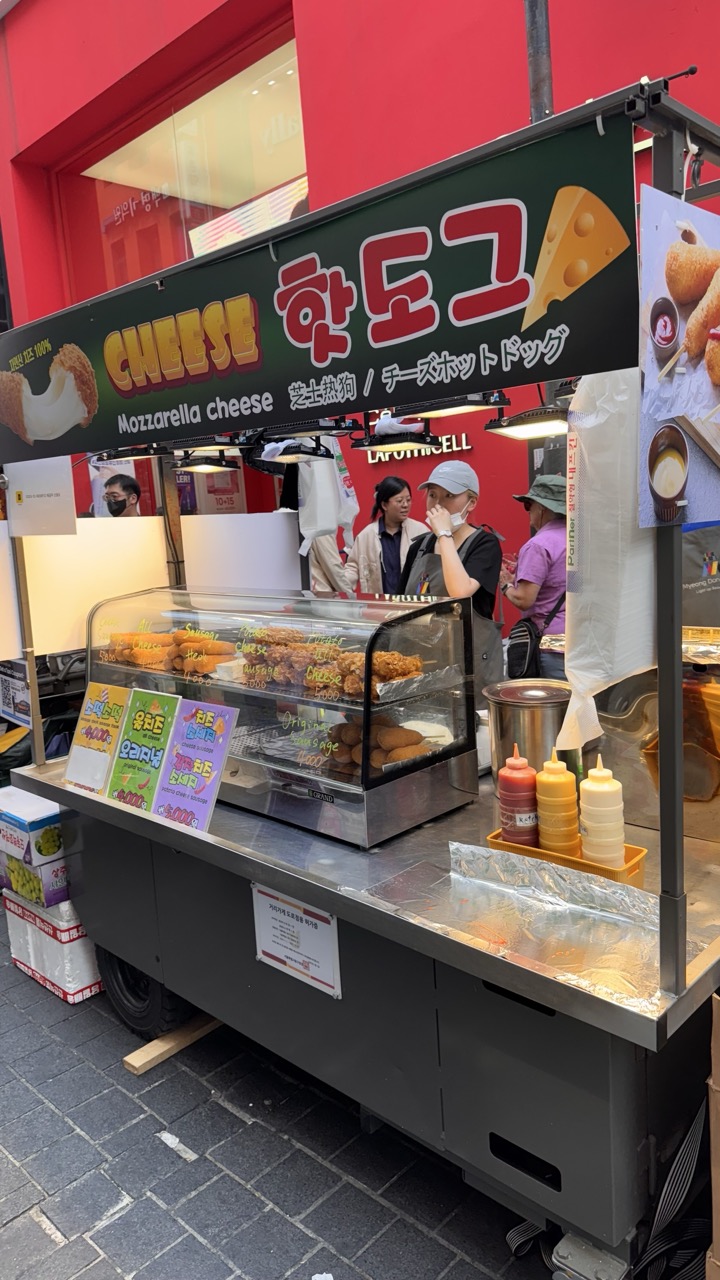

1. Overall Rating (0–10) — 6.0
This photograph captures the vibrant energy of a street food stall in a bustling urban setting, where the bright signage and array of snacks evoke a sense of immediacy and indulgence. The composition is lively and detailed, yet the visual clutter and busy background distract from a clear focal point. While it effectively conveys the atmosphere of a Korean street market, the image feels more like a snapshot than a curated scene—documentary in intent, but lacking in artistic cohesion.
2. Composition (0–10) — 5.5
The frame is crowded with signage, people, and objects, creating a sense of depth but also visual chaos. The central food display is well-placed, but the overabundance of elements in the background and foreground dilutes focus.
3. Lighting (0–10) — 6.0
Natural daylight provides even illumination, with overhead lights enhancing the visibility of the food. The lighting is functional but flat, failing to add dramatic contrast or mood to the scene.
4. Color & Tone (0–10) — 6.5
The bold reds and yellows of the signage create a lively palette, complemented by the metallic sheen of the cart and the warm tones of the food. The colors are vivid but slightly oversaturated, giving the image a commercial, almost garish quality.
5. Creativity (0–10) — 6.0
The image captures a common street food scene with authenticity, but the approach is conventional. The use of language and branding adds cultural specificity, but the composition lacks a unique visual angle or narrative twist.
6. Technical Quality (0–10) — 7.0
The focus is sharp on the food display and signage, and the image is free of major technical flaws. However, the overall image lacks depth due to the busy framing and lack of intentional composition.
7. Emotional Impact (0–10) — 5.5
The photograph evokes a sense of curiosity and hunger, but the overwhelming details prevent a deeper emotional connection. It feels more like an observation than an invitation into the moment.


1. Overall Rating (0–10) — 6.0
This photograph captures the vibrant energy of a Korean street food stall, where the sensory appeal of sizzling cheese hot dogs is almost palpable. The scene is rich with cultural detail—text, signage, and the bustle of a busy market—but the image feels more like a snapshot than a composed photograph. While it successfully conveys the atmosphere of a lively urban food scene, the lack of visual focus and overexposure in the background diminish the overall impact.
2. Composition (0–10) — 5.5
The frame is cluttered with signage, people, and objects, creating a sense of visual chaos. The food cart is slightly off-center, and the diagonal roofline draws the eye upward, disrupting the balance. A tighter crop would better emphasize the stall and its offerings.
3. Lighting (0–10) — 6.0
Natural daylight illuminates the scene, but the harsh overhead lighting creates glare on the glass display and flattens the textures. The contrast between the bright sign and the shadowed areas under the canopy adds visual interest, though some detail is lost in the highlights.
4. Color & Tone (0–10) — 6.5
The colors are vivid and saturated, particularly the reds and yellows of the signage and food. However, the overall palette leans toward a slightly cool, artificial tone, which contrasts with the warm, inviting nature of the food. The red fire extinguisher adds a strong pop of color that draws attention.
5. Creativity (0–10) — 6.0
The image captures a dynamic moment in a busy street food environment, but the approach is straightforward and documentary in nature. The inclusion of multiple languages and cultural cues suggests a story, but the photograph doesn’t elevate the scene into something more than observational.
6. Technical Quality (0–10) — 7.0
The image is sharp and clear, with good focus on the food cart and its immediate surroundings. The depth of field is adequate, though some background elements are distracting due to their proximity and brightness.
7. Emotional Impact (0–10) — 5.5
The photograph evokes a sense of urban energy and culinary delight, but the emotional resonance is muted by the lack of a clear focal point or narrative. The viewer is invited to observe, but not to feel deeply connected to the moment.


1. Overall Rating (0–10) — 6.0
This photograph captures a vibrant street food stall with a playful, pop-culture twist, blending culinary tradition with modern celebrity branding. The inclusion of Ja Jang Myeong’s image creates an immediate connection to K-pop and Korean food culture, but the image’s visual clutter and lack of compositional focus dilute its impact. While it succeeds in documenting a moment of urban life, the photograph feels more like a snapshot than a carefully composed image, with competing elements that distract from a cohesive narrative.
2. Composition (0–10) — 5.5
The framing is busy and slightly off-center, with multiple signs, people, and objects competing for attention. The food stall dominates the center, but the inclusion of the tire and various signs disrupts visual flow, creating a sense of chaos rather than harmony.
3. Lighting (0–10) — 6.0
Natural daylight provides even illumination, allowing details to be visible without harsh shadows. However, the lighting is flat and unremarkable, failing to enhance the scene’s energy or create mood.
4. Color & Tone (0–10) — 6.5
The red and white signage stands out against the neutral tones of the surroundings, creating visual contrast. The colors are somewhat saturated, particularly the reds and yellows, but the overall palette lacks depth and cohesion.
5. Creativity (0–10) — 7.0
The fusion of Korean street food with celebrity branding is clever and timely, reflecting contemporary cultural trends. The use of the same image across multiple signs adds a playful, repetitive quality that feels intentional and engaging.
6. Technical Quality (0–10) — 7.0
The image is sharp and in focus, with clear details visible in the signage and food preparation area. The exposure is balanced, though the depth of field is shallow, blurring some background elements.
7. Emotional Impact (0–10) — 5.5
The photograph evokes a sense of curiosity and amusement, particularly for those familiar with K-pop culture. However, the lack of emotional depth and the crowded composition prevent a stronger connection, leaving the viewer more entertained than moved.
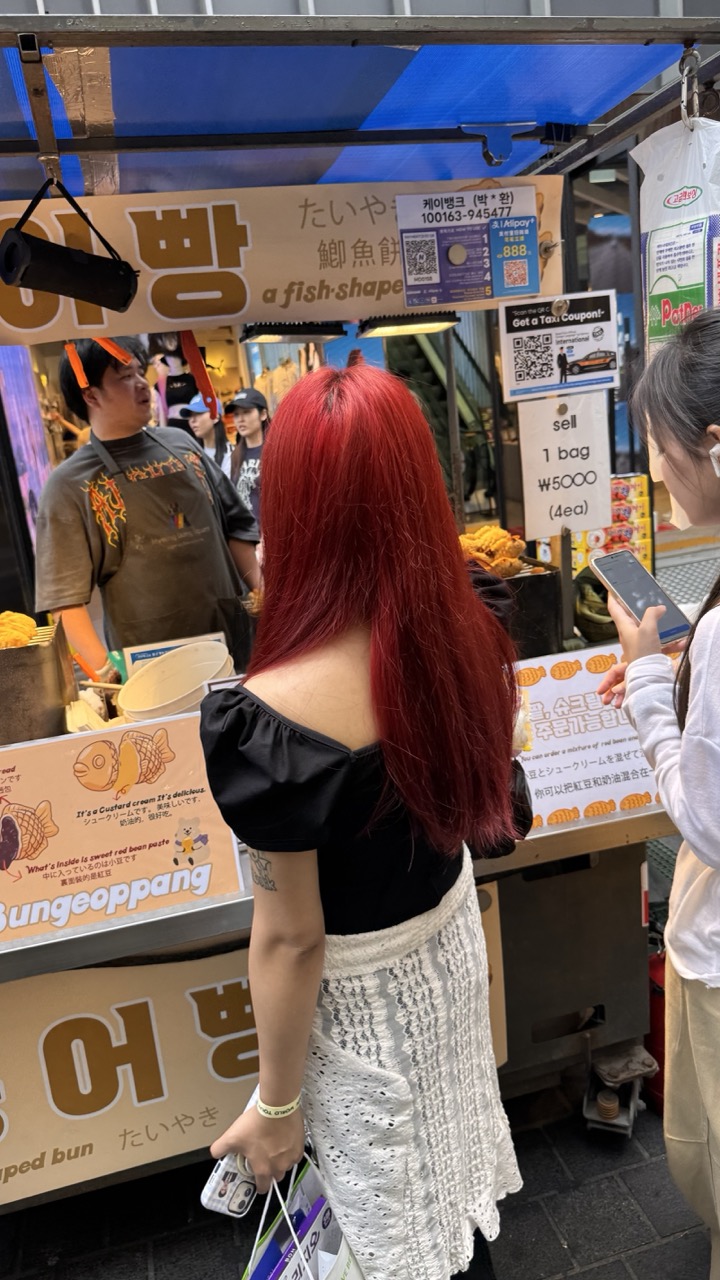

1. Overall Rating (0–10) — 6.0
This photograph captures a vibrant street food moment, where the vivid red hair of the central figure creates an immediate visual anchor against the muted tones of the market backdrop. The scene feels candid and immersive, offering a glimpse into daily life at a Korean street stall. While the composition and lighting convey a sense of authenticity, the image lacks a strong focal point and feels slightly cluttered, preventing it from achieving greater emotional or aesthetic depth.
2. Composition (0–10) — 5.5
The framing is tight and centered on the back of the red-haired woman, which creates a sense of intimacy but also limits the viewer’s ability to fully absorb the surrounding environment. The vendor and signage are partially cut off, and the presence of multiple signs and objects in the foreground slightly disrupts visual flow.
3. Lighting (0–10) — 5.0
The lighting appears to be ambient daylight with a slight overcast quality, resulting in soft, even illumination that minimizes harsh shadows. However, the lack of directional light or contrast gives the image a flat, documentary feel, reducing its dynamic impact.
4. Color & Tone (0–10) — 6.5
The bold red hair stands out vividly against the neutral and muted tones of the background, creating a striking color contrast. The overall palette is restrained, with earthy browns and grays dominating, but the red adds a pop of energy that draws the eye.
5. Creativity (0–10) — 6.0
The photograph leverages a candid, street-level perspective to tell a story of urban life and cultural experience. The use of color and the focus on an ordinary moment give it a sense of authenticity, though the approach remains observational rather than artistically inventive.
6. Technical Quality (0–10) — 7.0
The image is sharp and clear, with good detail in both the foreground subject and background elements. Focus is consistent, and the exposure is balanced, allowing readable text on the signs and visible textures in the clothing and surroundings.
7. Emotional Impact (0–10) — 5.5
The image evokes a sense of curiosity and connection to a real-world moment, but the emotional resonance is muted by the lack of a strong narrative or expressive lighting. The viewer is invited to observe rather than feel, leaving the scene as a snapshot rather than a compelling story.


1. Overall Rating (0–10) — 6.0
This photograph captures a candid moment at a bustling street food stall, where the rhythm of commerce unfolds in real time. The vendor’s focused expression and the vibrant display of fruit cups convey a sense of everyday vitality, though the image’s immediacy is tempered by a lack of visual refinement. While the scene feels authentic and grounded, it stops short of achieving a compelling artistic narrative—more a snapshot than a story.
2. Composition (0–10) — 5.5
The subject is placed off-center, creating a sense of movement, but the cluttered background and uneven framing dilute the focus. A tighter crop would emphasize the transaction and the vendor’s expression.
3. Lighting (0–10) — 6.0
Overhead fluorescent lights provide even illumination, highlighting the colorful fruit cups and the vendor’s hands. However, the harshness of the light flattens depth and casts a sterile glow, undercutting the warmth of the moment.
4. Color & Tone (0–10) — 6.5
The bright oranges and reds of the fruit contrast sharply with the muted grays and blacks of the vendor’s clothing and stall. The palette feels energetic, though the overall tone leans toward a clinical neutrality, preventing the image from radiating true vibrancy.
5. Creativity (0–10) — 6.0
The photograph captures a familiar street scene with a sense of authenticity, but it lacks a unique visual perspective or interpretive twist. The moment is observed rather than interpreted.
6. Technical Quality (0–10) — 7.0
The image is sharp and clear, with good focus on the vendor and the cups. The exposure is balanced, though the depth of field is shallow, causing slight softness in the background.
7. Emotional Impact (0–10) — 5.5
The image evokes a sense of routine and labor, but the emotional resonance is muted. The viewer is invited to observe, but not to feel—there’s a distance between the subject and the viewer that prevents deeper connection.


1. Overall Rating (0–10) — 6.0
This photograph captures a lively moment at a Korean fruit stall, brimming with the vibrant energy of a bustling market. The subject’s cheerful wave and the colorful display of Shine Muscat grapes create a sense of warmth and invitation. While the image effectively conveys a slice of everyday life, its composition and lighting feel somewhat candid and unrefined, preventing it from achieving a more polished, artistic presence.
2. Composition (0–10) — 5.5
The framing is slightly cluttered, with multiple signs and objects competing for attention. The subject is centered but partially obscured by signage, weakening visual focus. A tighter crop would better highlight the human element and create a stronger narrative.
3. Lighting (0–10) — 6.0
The scene is lit by mixed artificial sources, creating uneven illumination and some glare on the glass display. While adequate for capturing the details, the lighting lacks direction and mood, giving the image a flat, documentary feel.
4. Color & Tone (0–10) — 6.5
The palette is bright and engaging, with pops of green from the grapes, red from the strawberries, and yellow from the signage. However, the colors appear slightly oversaturated, and the overall tone leans toward the sterile, typical of a commercial environment.
5. Creativity (0–10) — 6.0
The image is observational rather than interpretive. While it captures a culturally rich moment, it relies on recognizable elements—Korean text, produce, and a smiling vendor—without a unique visual perspective or artistic twist.
6. Technical Quality (0–10) — 7.0
The image is sharp and clear, with good detail in the foreground. Focus is well-managed on the subject and the fruit display, though the background is slightly soft, reducing depth.
7. Emotional Impact (0–10) — 6.5
There’s a genuine sense of joy and hospitality conveyed through the subject’s gesture and expression. The viewer is invited into a familiar, pleasant scene, though the emotional resonance is somewhat muted by the visual busyness and lack of atmospheric depth.
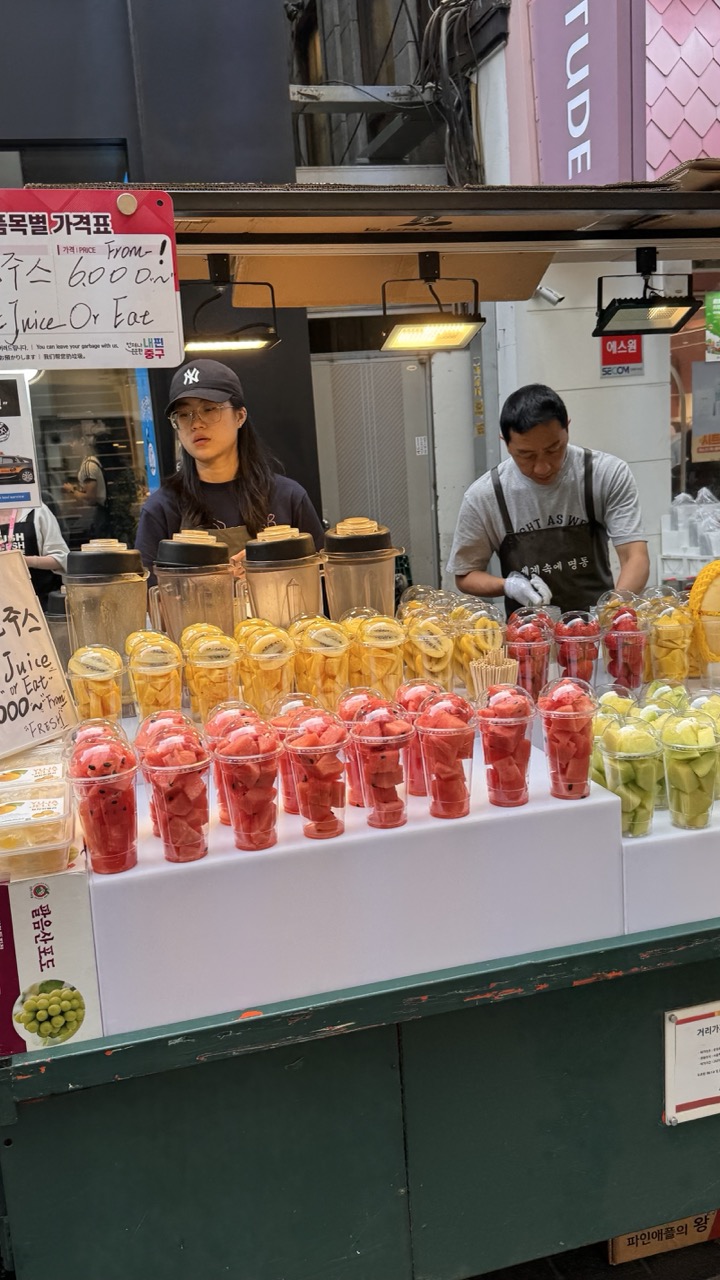

1. Overall Rating (0–10) — 6.0
This photograph captures the vibrant energy of a street food stall, where the bright, colorful fruit cups draw the eye and suggest a lively urban rhythm. While the composition is engaging and the scene is rich with cultural detail, the image feels slightly overexposed and cluttered, preventing it from achieving a more refined visual harmony. The candid nature of the moment adds authenticity, but a more deliberate framing could elevate the photograph from documentation to storytelling.
2. Composition (0–10) — 6.0
The frame is filled with a busy arrangement of fruit cups and signage, creating a sense of abundance but also visual noise. The two vendors are positioned slightly off-center, with the woman on the left and the man on the right, creating a loose balance. A tighter crop focusing on the fruit display and the interaction between the vendors could improve focus and narrative flow.
3. Lighting (0–10) — 6.5
The scene is illuminated by a mix of ambient daylight and artificial overhead lights, resulting in a slightly harsh, flat quality. The overhead lamps cast a warm glow that enhances the colors of the fruit, but the overall lighting lacks depth and contrast, contributing to a somewhat washed-out appearance.
4. Color & Tone (0–10) — 7.0
The palette is rich and varied, with the reds of the watermelon, yellows of the mango, and greens of the grapes creating a visually appealing contrast. The white display counter helps unify the composition, while the muted tones of the background keep the focus on the colorful produce. The color temperature is slightly warm, enhancing the inviting feel of the stall.
5. Creativity (0–10) — 6.5
The image successfully captures a slice of everyday life in a bustling market, with the fruit cups serving as a colorful focal point. The inclusion of Korean signage and cultural details adds authenticity and context. While the concept is grounded in realism, the photograph could benefit from a more intentional artistic approach to elevate its visual impact.
6. Technical Quality (0–10) — 6.5
The image is sharp and clear, with good detail in the fruit and signage. However, the exposure is slightly high, causing some loss of detail in the brighter areas. The focus is consistent across the frame, but the overall technical execution is held back by the lighting and composition.
7. Emotional Impact (0–10) — 6.0
The photograph evokes a sense of warmth and vibrancy, capturing the inviting atmosphere of a street food stall. The bright colors and human presence create a connection to the everyday joy of fresh food and local culture. While the emotional resonance is present, it is somewhat muted by the cluttered composition and flat lighting.


1. Overall Rating (0–10) — 6.8
This photograph captures the vibrant energy of a street food stall in a bustling urban setting, where the colorful candied fruits and Korean signage create an immediate sense of place. The candid composition and natural lighting lend authenticity, though the cluttered background and slightly awkward framing dilute the visual impact. While it effectively conveys the atmosphere of a lively market, it lacks the compositional refinement to feel like a polished piece of street photography.
2. Composition (0–10) — 6.0
The frame is slightly unbalanced, with the vendor and fruit skewers off-center and a busy background that competes for attention. A tighter crop would better focus on the main subject and reduce visual noise.
3. Lighting (0–10) — 6.5
Natural daylight provides even illumination, though it’s somewhat flat and lacks dynamic shadows. The overhead signage creates a slight glare, slightly washing out details in the upper portion of the frame.
4. Color & Tone (0–10) — 7.5
The bright reds of the candied fruits and the bold signage create a strong visual contrast against the neutral tones of the stall and pavement. The palette is lively and engaging, with the Korean flag and text adding cultural context and vibrancy.
5. Creativity (0–10) — 7.0
The image successfully captures a slice of everyday life with a strong sense of cultural specificity. The inclusion of the "take out" sign and the Korean text adds narrative depth, making it more than a simple snapshot.
6. Technical Quality (0–10) — 7.0
The image is sharp and clear, with good focus on the fruit skewers and vendor. However, the slight angle and visible clutter reduce overall technical polish.
7. Emotional Impact (0–10) — 6.5
The photograph evokes a sense of curiosity and warmth, inviting the viewer into a moment of street-side indulgence. While it doesn’t elicit deep emotion, it captures a pleasant, relatable scene of urban life.
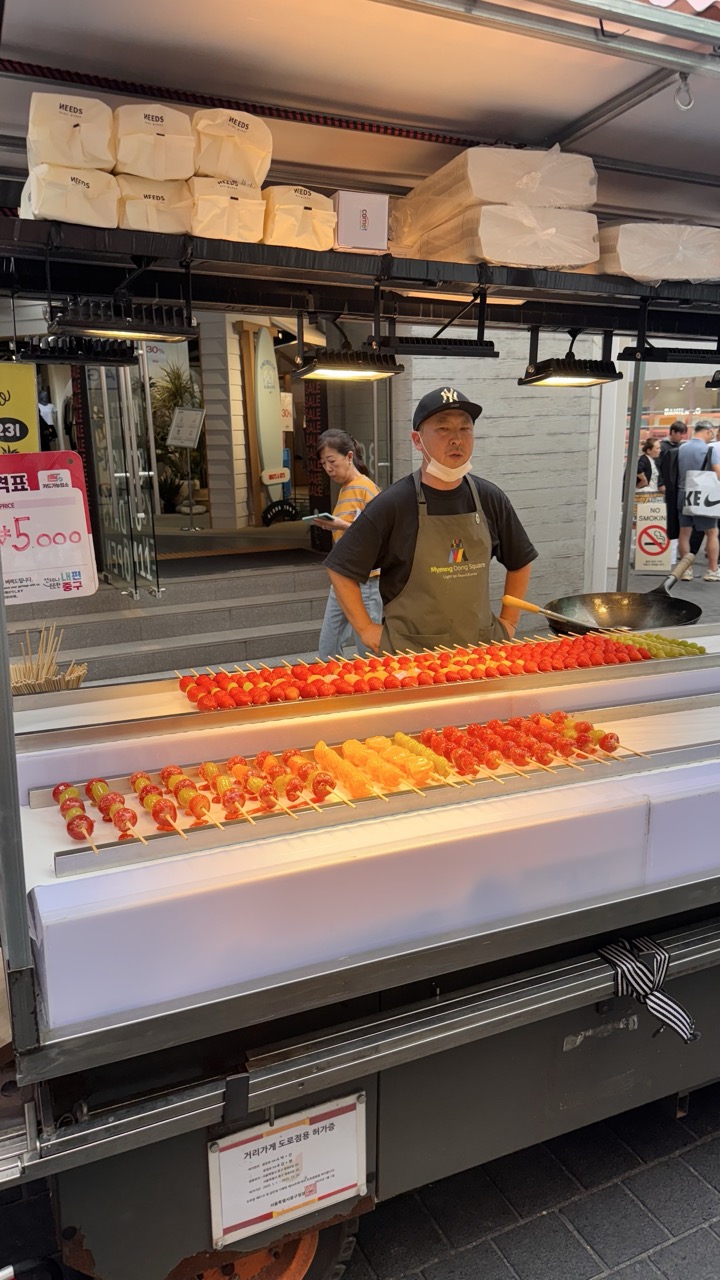

1. Overall Rating (0–10) — 6.8
This photograph captures the vibrant energy of a street food vendor in a bustling urban setting, where the colorful skewers of candied fruit draw the eye and evoke a sense of playful indulgence. The composition balances the bright, sugary display with the calm presence of the vendor, grounding the scene in authenticity. While the image is rich in detail and cultural context, it feels slightly overexposed and lacks the visual tension needed to elevate it beyond a simple documentary snapshot.
2. Composition (0–10) — 6.5
The vendor is centered but slightly off-kilter, creating a natural, candid feel. The diagonal lines of the skewers guide the eye through the frame, though the cluttered background and uneven framing of the stall edges distract from the main subject.
3. Lighting (0–10) — 6.0
Harsh overhead lighting flattens the image, washing out subtle textures and creating glare on the glass case. While functional for clarity, it diminishes the warmth and depth of the scene.
4. Color & Tone (0–10) — 7.5
The vivid reds and oranges of the candied fruits pop against the neutral backdrop, creating a lively, appetizing palette. The cool white and gray tones of the stall and pavement provide contrast without overwhelming the vibrancy of the food.
5. Creativity (0–10) — 6.5
The image successfully captures a slice of everyday life with cultural specificity, but its approach is observational rather than interpretive. The scene is engaging, but lacks a unique visual or narrative twist.
6. Technical Quality (0–10) — 7.0
The image is sharp and well-focused, with clear detail in the textures of the fruit and the vendor’s clothing. However, the exposure and lighting choices limit overall visual impact.
7. Emotional Impact (0–10) — 6.0
The photograph evokes a sense of familiarity and quiet charm, inviting the viewer into a moment of urban sustenance. While it connects through relatability, it stops short of deeper emotional resonance.
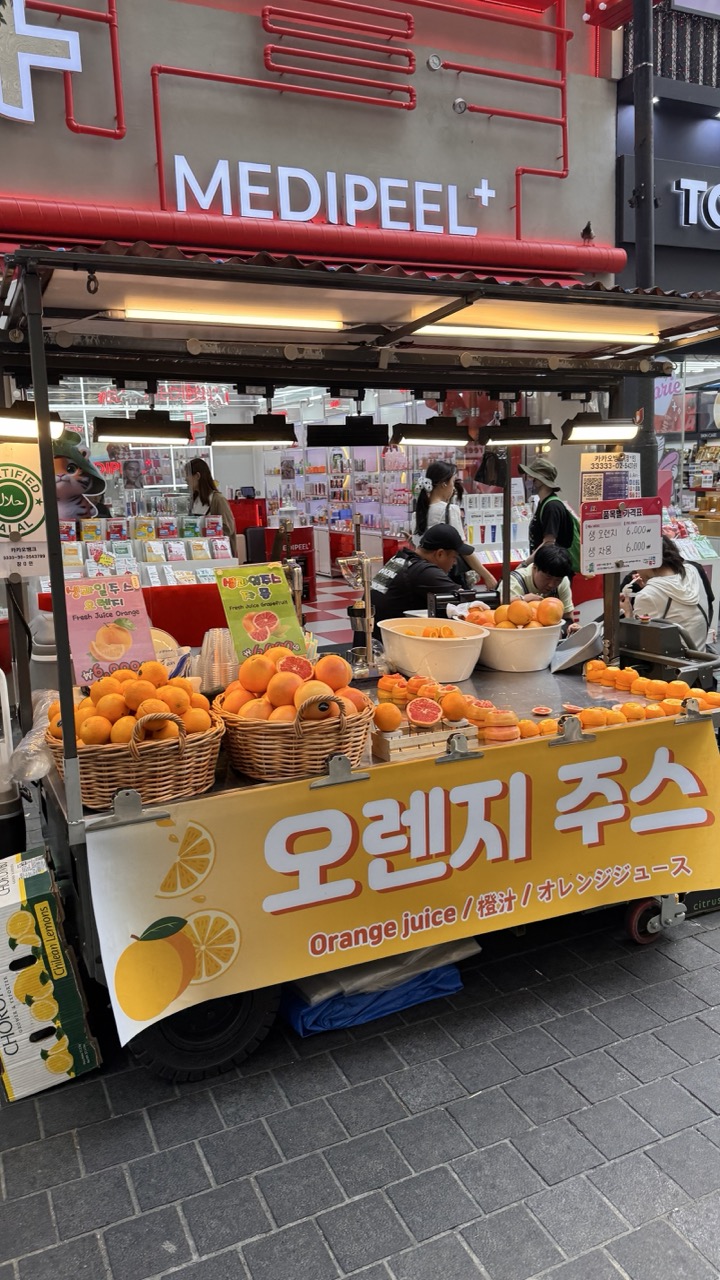

1. Overall Rating (0–10) — 6.0
This photograph captures the vibrant energy of a street-side orange juice stall in a bustling urban setting, with the Medipeel+ storefront providing a bold backdrop. The scene is rich with detail and color, conveying a sense of immediacy and daily life, yet the composition feels slightly cluttered and the lighting lacks refinement, preventing it from achieving a more polished aesthetic. The image succeeds as a candid document of city culture but falls short of visual harmony.
2. Composition (0–10) — 5.5
The framing is wide, capturing too much background distraction and creating a sense of visual overload. The stall is centered but competes for attention with the surrounding signage and people, reducing focus on the main subject.
3. Lighting (0–10) — 5.0
Harsh overhead fluorescent lights dominate the scene, casting flat, unflattering illumination that flattens depth and muddies shadows. While functional for visibility, the lighting lacks warmth and fails to enhance the natural vibrancy of the oranges.
4. Color & Tone (0–10) — 6.5
The dominant orange hues of the fruit and signage create a lively, energetic palette, complemented by the red accents of the Medipeel+ sign. However, the overall tone is slightly washed out, with muted contrast and a cool gray pavement that detracts from the warmth of the scene.
5. Creativity (0–10) — 6.0
The image captures a moment of everyday urban life with a layered, documentary quality. While the concept is straightforward and grounded in real-world context, it lacks a strong artistic vision or unique perspective to elevate it beyond a simple snapshot.
6. Technical Quality (0–10) — 7.0
The image is sharp and well-focused, with clear details in the signage, fruit, and background elements. However, the wide-angle perspective and uneven lighting introduce slight distortion and visual clutter.
7. Emotional Impact (0–10) — 5.5
The photograph evokes a sense of place—busy, lively, and familiar—but its emotional resonance is limited by the lack of a central narrative or emotional focus. It feels more like a passing moment than a deeply connecting image.
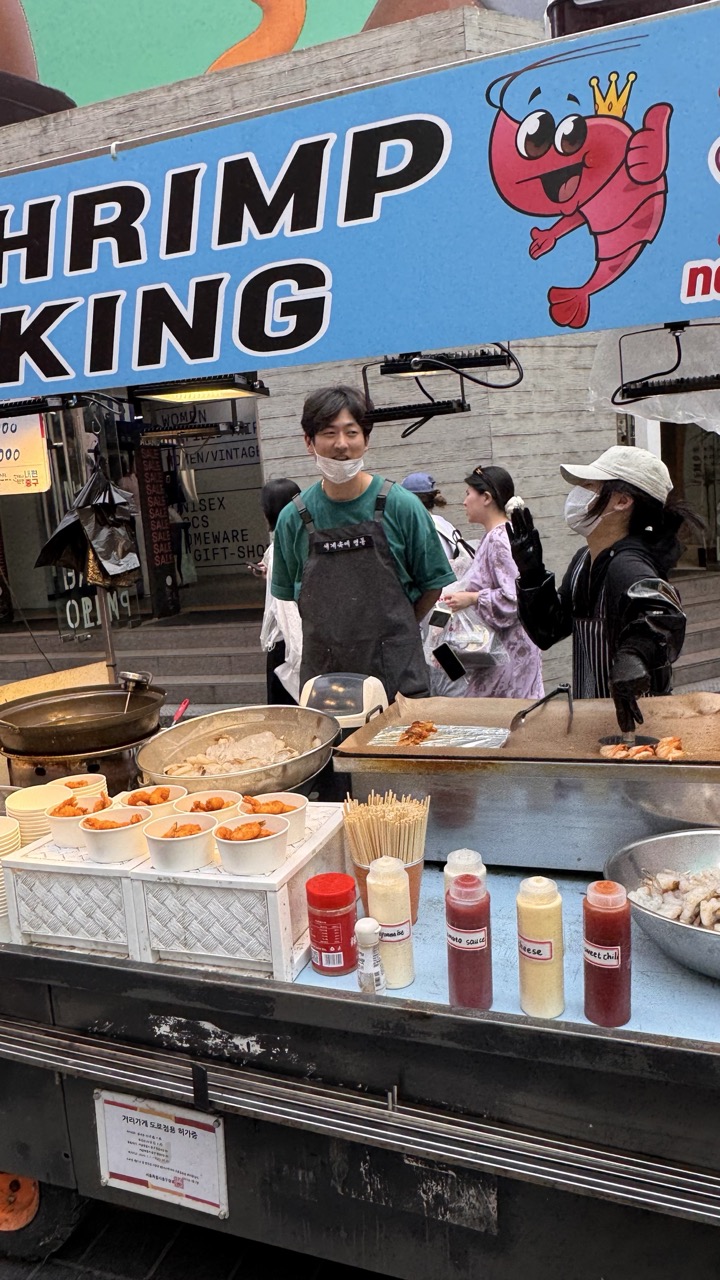

1. Overall Rating (0–10) — 6.8
This photograph captures the vibrant energy of a street food stall with a sense of immediacy and authenticity. The bold “Shrimp King” sign and cheerful cartoon mascot inject a playful tone, while the vendor’s focused expression and the array of condiments and prepared dishes ground the scene in real-world activity. The image succeeds in conveying the rhythm of street commerce, though the slightly cluttered composition and flat lighting temper its visual impact.
2. Composition (0–10) — 6.0
The frame includes a wealth of detail but feels slightly unbalanced, with the vendor slightly off-center and the top-heavy sign dominating the upper third. A tighter crop could better focus attention on the interaction between vendor and customer.
3. Lighting (0–10) — 5.5
Natural daylight provides even illumination, but the lack of directional shadowing gives the scene a flat, documentary quality. The overhead fluorescent light adds to the functional, unembellished feel.
4. Color & Tone (0–10) — 6.5
The dominant blue of the sign creates a strong visual anchor, while the warm tones of the food and the red condiments offer contrast. However, the overall palette is somewhat muted, with the colors appearing slightly washed out.
5. Creativity (0–10) — 6.0
The image captures a slice of urban life with a sense of narrative—food, culture, and movement. While not particularly original in concept, the inclusion of the cartoon mascot and the vendor’s attire adds character and personality.
6. Technical Quality (0–10) — 7.0
The image is sharp and clear, with good detail in the food and signage. The focus is consistent, and the camera appears to be stable, though the slight noise and overexposed highlights reduce overall polish.
7. Emotional Impact (0–10) — 6.0
The photo evokes a sense of place and daily rhythm—familiar, relatable, and grounded. It invites the viewer to imagine the smell of fried shrimp and the sounds of the street, though it stops short of deep emotional resonance.
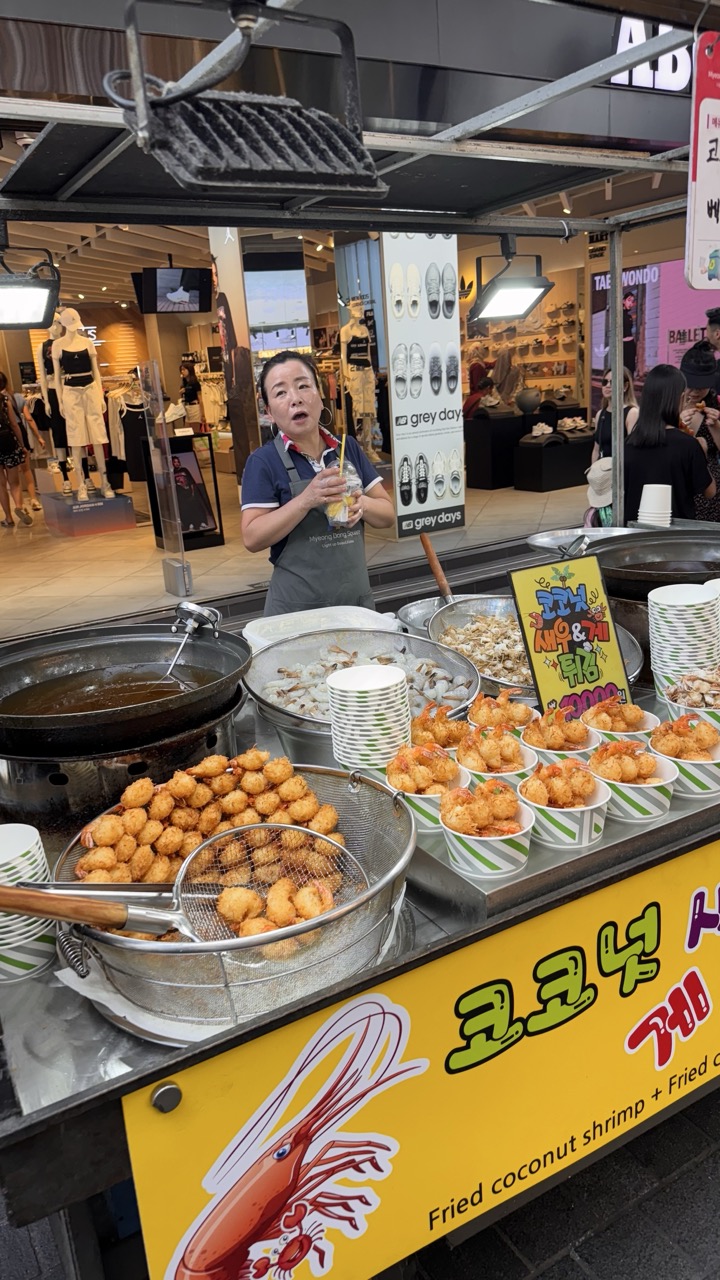

1. Overall Rating (0–10) — 7.0
This vibrant street food scene captures the energy and authenticity of a bustling Korean market, where the warmth of human interaction blends with the sensory appeal of fresh, fried coconut shrimp. The candid expression of the vendor adds a layer of personality, grounding the image in lived experience. While the composition feels slightly crowded, the rich textures and cultural specificity elevate it beyond a simple snapshot into a compelling slice of daily life.
2. Composition (0–10) — 6.5
The frame is busy, with overlapping elements like the fryer, signage, and background storefront creating visual clutter. However, the vendor is well-placed as the focal point, and the diagonal lines of the stall and signage guide the eye toward her. A tighter crop could improve balance and reduce distractions.
3. Lighting (0–10) — 7.0
Natural daylight dominates, supplemented by artificial lights from the stall and nearby store, creating a balanced exposure. The overhead lamp casts a warm glow on the food, enhancing its appetizing appeal, while the ambient light maintains clarity throughout the scene.
4. Color & Tone (0–10) — 8.0
The bright yellow sign and red cartoon shrimp provide a bold pop of color that draws attention, contrasting effectively with the neutral tones of the background. The warm golden hues of the fried shrimp harmonize with the overall palette, creating a lively and inviting atmosphere.
5. Creativity (0–10) — 7.0
The image successfully captures a moment of cultural authenticity and street-level storytelling. While not highly stylized, the candidness and authenticity lend it a unique charm, making it feel both documentary and artistic.
6. Technical Quality (0–10) — 7.5
The image is sharp and well-focused, with clear details in both the food and the vendor’s expression. The depth of field appropriately isolates the subject, and there are no noticeable technical flaws such as blur or noise.
7. Emotional Impact (0–10) — 7.5
The photograph evokes a sense of warmth, energy, and connection—inviting the viewer into a moment of everyday joy and commerce. The vendor’s expression suggests pride and engagement, fostering a quiet emotional resonance that lingers beyond the frame.


1. Overall Rating (0–10) — 6.8
This photograph captures the vibrant energy of a bustling street food scene, where the sizzle of lamb skewers and the hum of city life merge into a compelling urban narrative. The vendor’s focused posture and the colorful signage inject personality and authenticity into the frame, while the layered composition draws the eye through a dynamic interplay of foreground activity and background motion. Though the image is rich in detail and context, its slightly cluttered framing and flat lighting prevent it from achieving a more refined visual harmony.
2. Composition (0–10) — 6.5
The shot uses a low-angle perspective to emphasize the food cart, creating a sense of immediacy, but the overlapping elements—signs, lights, and passersby—create a slightly chaotic arrangement. The vendor is well-placed as a focal point, though the diagonal flow of the street and signage leads the eye unevenly.
3. Lighting (0–10) — 5.5
Harsh overhead fluorescent lights dominate the scene, casting flat, unflattering illumination on the subject and creating glare on reflective surfaces. While functional for visibility, the lighting lacks depth and fails to enhance the mood, giving the image a candid, almost documentary feel.
4. Color & Tone (0–10) — 6.0
The palette is lively, with bold reds and yellows from the signage and the warm tones of the grilled meat providing visual contrast. However, the overall tone is slightly washed out, and the dominance of artificial light reduces color saturation and vibrancy.
5. Creativity (0–10) — 7.0
The image successfully captures a slice of everyday life with a strong sense of place—Myeongdong’s signature food culture. The juxtaposition of traditional street food with modern signage and digital payment options adds a contemporary layer, suggesting a story of cultural continuity and change.
6. Technical Quality (0–10) — 7.5
The focus is sharp on the central subject, with adequate detail visible in the food and signage. The image is free from major technical flaws like motion blur or noise, though the low angle and tight framing limit the overall clarity.
7. Emotional Impact (0–10) — 6.5
There’s a sense of warmth and authenticity in the vendor’s concentration and the lively street behind, evoking a connection to the rhythm of daily life. However, the emotional resonance is tempered by the visual clutter and lack of atmospheric lighting, which keeps the viewer from fully immersing in the moment.
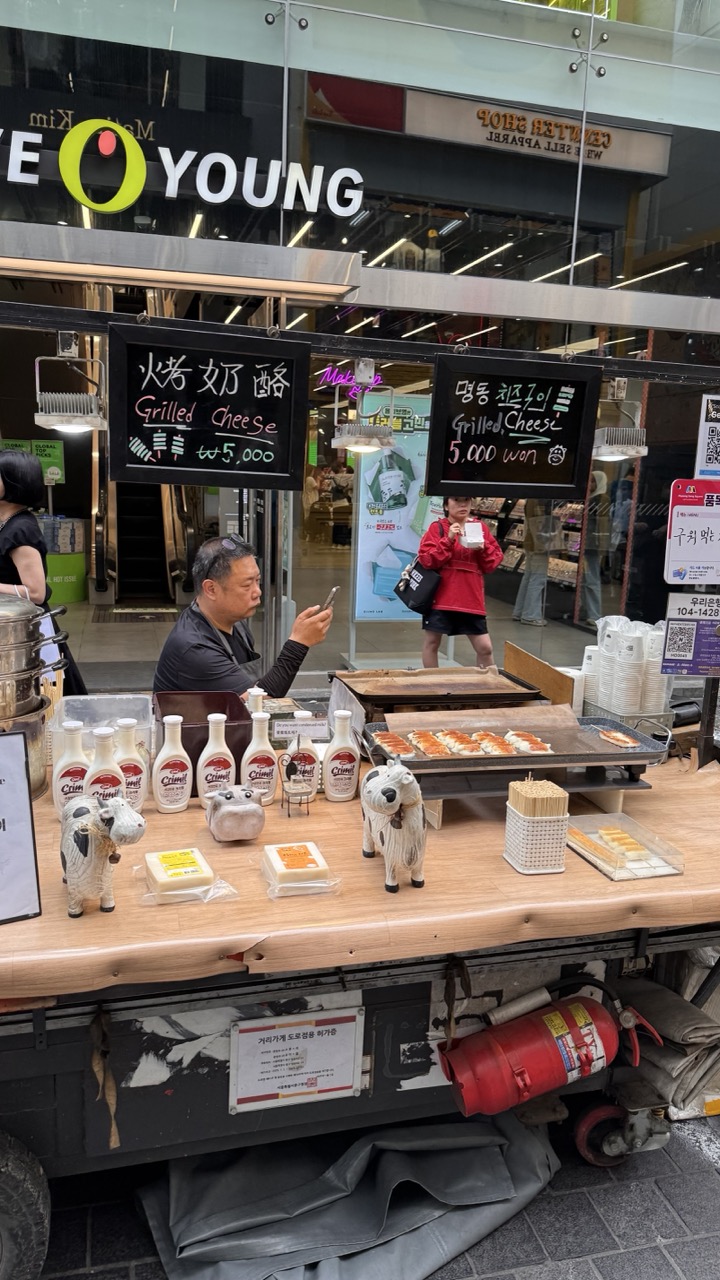

1. Overall Rating (0–10) — 6.0
This photograph captures the vibrant energy of a street food stall in a bustling urban setting, where the interplay of commerce and culture unfolds in real time. The scene is rich with detail—signs in Korean and English, the sizzle of grilled cheese, and the quiet focus of the vendor—all contributing to a sense of authenticity. While the composition is lively and grounded in reality, it lacks visual cohesion, with overlapping elements and a slightly cluttered foreground that distract from the central narrative.
2. Composition (0–10) — 5.5
The frame is crowded, with too many competing elements—signs, bottles, toys, and background activity—pulling attention away from the main subject. A tighter crop would emphasize the vendor and the food preparation process, creating a stronger focal point.
3. Lighting (0–10) — 6.0
Natural daylight illuminates the scene evenly, preserving detail in both the foreground and background. However, the bright, diffuse lighting flattens the image, minimizing shadows and depth, which weakens the visual drama.
4. Color & Tone (0–10) — 6.5
The palette is dominated by neutral browns, whites, and grays, punctuated by the red of the fire extinguisher and the vendor’s red shirt. While the colors are natural and unobtrusive, they lack vibrancy, resulting in a muted, documentary-style feel.
5. Creativity (0–10) — 6.5
The image succeeds in capturing an authentic moment of daily life, with thoughtful details like the cow figurines and multilingual signage adding character. However, the approach is observational rather than artistic, offering little beyond a snapshot of a moment.
6. Technical Quality (0–10) — 7.0
The image is sharp and well-exposed, with clean detail throughout. Focus is consistent, and the resolution is sufficient to read text and identify objects, though the overall composition limits the impact of the technical clarity.
7. Emotional Impact (0–10) — 5.5
The photograph conveys a sense of routine and quiet industry, but the lack of emotional focus or narrative tension keeps the viewer at a distance. The scene feels more like a record of a place than an invitation into a story.


1. Overall Rating (0–10) — 6.0
This photograph captures the vibrant energy of a bustling Korean street food scene, where the bold red signage and bright red lobsters draw the eye with immediacy and appetite. The composition is lively and immersive, reflecting the chaotic charm of a city alley, yet the visual clutter and uneven framing slightly undermine its aesthetic cohesion. While the image effectively conveys the atmosphere of a busy market, it struggles to balance the overwhelming details with a clear focal point.
2. Composition (0–10) — 5.5
The wide-angle perspective includes too much background activity, creating a sense of visual noise. The food stall is centered but competes with surrounding signage and pedestrians, diluting the subject’s prominence.
3. Lighting (0–10) — 6.0
Natural daylight provides even illumination, but the overcast sky results in flat, diffused light that lacks contrast and depth. The reds of the sign and lobsters stand out, but the overall tone is somewhat muted.
4. Color & Tone (0–10) — 6.5
The dominant reds and yellows of the signage create a strong visual anchor, while the neutral tones of the pavement and buildings offer contrast. However, the color palette feels slightly oversaturated, particularly in the signage, giving it a commercial, digital quality.
5. Creativity (0–10) — 6.0
The image successfully documents a cultural moment with authenticity, but its approach is more observational than artistic. The concept of street food as sensory experience is present, yet the execution leans toward snapshot documentation rather than intentional storytelling.
6. Technical Quality (0–10) — 7.0
The image is sharp and clear, with well-defined details in the signage and food items. Focus is consistent, and the depth of field is adequate for capturing the environment without significant blur.
7. Emotional Impact (0–10) — 6.5
The photograph evokes a sense of urban vibrancy and sensory appeal—especially through the sight and implied smell of roasted lobster. It invites the viewer into a lively street scene, though the emotional resonance is tempered by the lack of a singular human moment or narrative thread.
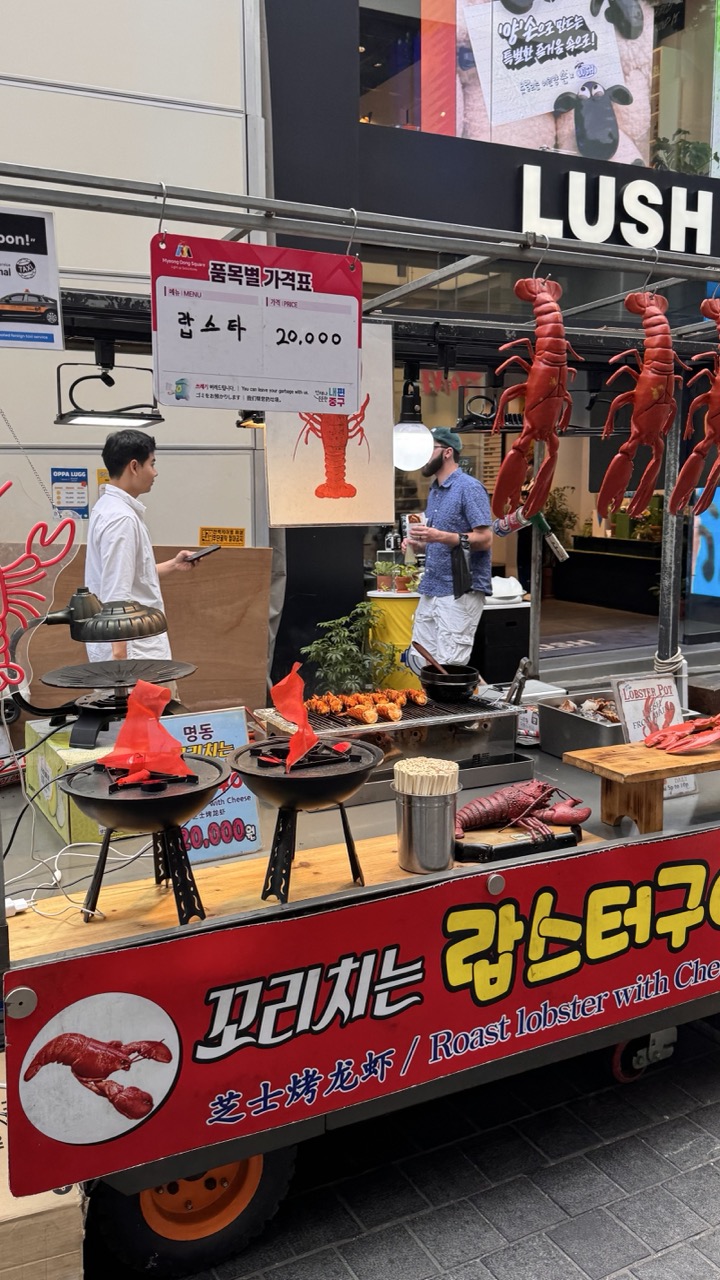

1. Overall Rating (0–10) — 6.0
This photograph captures a vibrant street food scene, where the bold reds of the lobster and signage create an energetic, almost theatrical atmosphere. The composition effectively conveys the sensory appeal of a live cooking station, though the cluttered background and competing elements slightly dilute its focus. While the image successfully communicates the excitement of a food truck experience, it feels more like a candid snapshot than a polished visual statement.
2. Composition (0–10) — 5.5
The framing is slightly off-center, with the food cart dominating the lower half and the background elements—signs, people, and storefronts—creating visual noise. A tighter crop or a more deliberate focus on the cooking process would enhance balance and clarity.
3. Lighting (0–10) — 6.0
Natural daylight illuminates the scene evenly, allowing the bright reds and colors to pop. However, the flat, overcast quality of the light reduces depth and shadow definition, slightly flattening the image’s dimensionality.
4. Color & Tone (0–10) — 7.0
The dominant reds of the lobster and signage create a bold, appetizing palette, while the contrasting yellows and whites on the sign add visual energy. The tone is lively and commercial, though the saturation feels slightly artificial, likely due to post-processing.
5. Creativity (0–10) — 6.5
The use of oversized lobster models and the dynamic setup of the food cart suggest a playful, attention-grabbing approach. The scene is memorable and culturally specific, offering a glimpse into a lively urban food culture, but the concept leans toward convention rather than innovation.
6. Technical Quality (0–10) — 7.0
The image is sharp and well-focused, with clear details in the signage and food preparation area. However, some areas appear slightly overexposed, particularly the white sign and the LUSH storefront, reducing tonal range.
7. Emotional Impact (0–10) — 6.0
The photograph evokes a sense of urban energy and culinary indulgence, drawing the viewer into a moment of sensory stimulation. While it captures the excitement of street food culture, it lacks a deeper emotional resonance, feeling more like a documentation than an evocative narrative.


1. Overall Rating (0–10) — 6.8
This image captures the vibrant energy of a bustling street food stall, where the familiar sight of taiyaki—a fish-shaped pastry—meets the layered textures of urban commerce. The scene is rich with cultural detail and candid motion, conveying a sense of daily rhythm and local flavor. While the composition feels slightly cluttered and the lighting is functional rather than evocative, the photograph succeeds in documenting a lively moment in a way that feels authentic and immersive.
2. Composition (0–10) — 6.0
The framing is slightly unbalanced, with the vendor off-center and the foreground dominated by the display of taiyaki. The background elements—shelves of merchandise and signage—create visual noise, competing for attention with the main subject.
3. Lighting (0–10) — 6.5
The lighting is bright and even, likely from overhead fluorescent fixtures, which ensures clarity but flattens shadows and reduces atmospheric depth. The mix of natural and artificial light gives the scene a neutral, documentary feel.
4. Color & Tone (0–10) — 6.0
The palette is dominated by warm browns of the taiyaki and wood counter, contrasted with the cool blue of the awning and the muted green of the wall. While the colors are distinct, they lack richness and vibrancy, giving the image a somewhat flat, commercial appearance.
5. Creativity (0–10) — 6.5
The photograph captures a unique cultural intersection—street food, retail, and urban life—through a candid lens. The blend of Korean and English signage, along with the French-inspired “Croissant Taiyaki” branding, adds a layer of playful hybridity, though the storytelling remains observational rather than conceptual.
6. Technical Quality (0–10) — 7.5
The image is sharp and well-focused, with clear details in the taiyaki, signage, and the vendor’s hands. The exposure is balanced, with no major over- or underexposed areas, and the depth of field appropriately isolates the subject from the background.
7. Emotional Impact (0–10) — 6.0
The image evokes a sense of everyday life and cultural familiarity, drawing the viewer into a moment of quiet activity. While it conveys warmth and authenticity, the lack of strong emotional contrast or narrative tension keeps the connection to the viewer at a surface level.
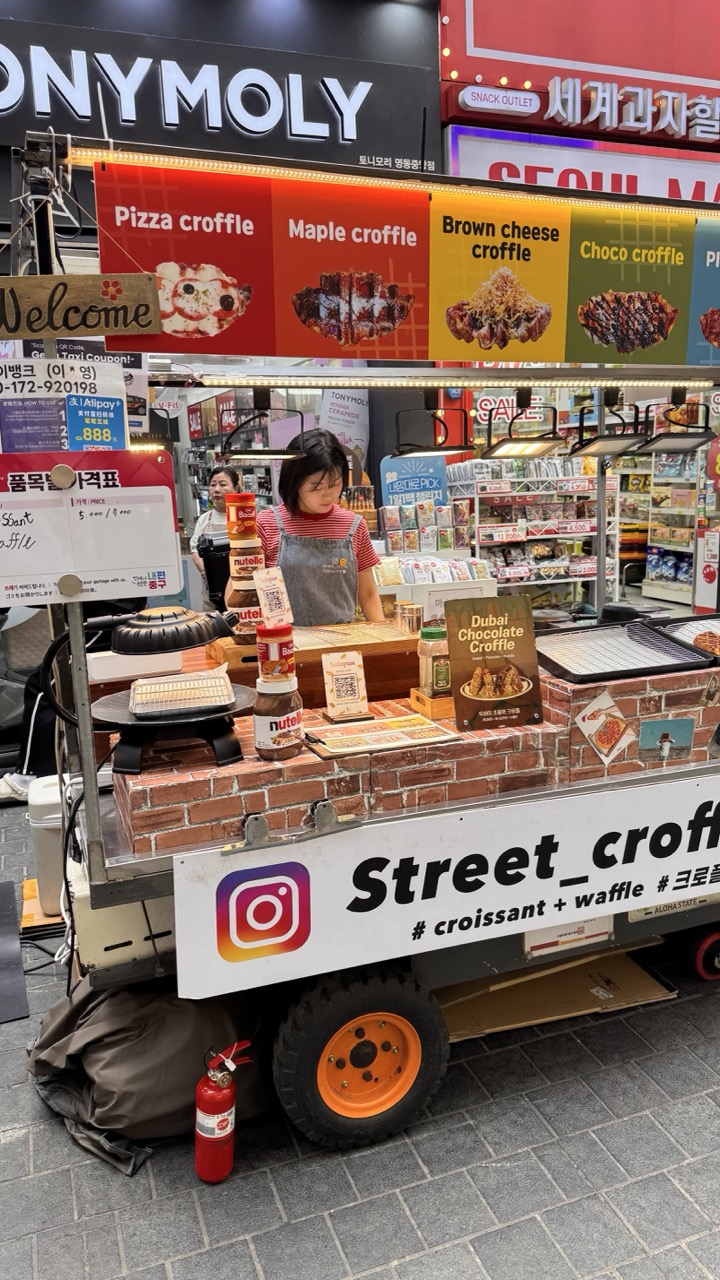

1. Overall Rating (0–10) — 6.0
This photograph captures the vibrant energy of a Korean street food scene, where the bright signage and bustling activity suggest a lively urban moment. The composition, though cluttered, effectively conveys the chaos and charm of a snack cart in a commercial district. While the image succeeds in documenting a slice of local culture, it lacks the visual cohesion and artistic refinement needed to elevate it beyond a simple snapshot.
2. Composition (0–10) — 5.5
The frame is crowded with text and objects, creating visual noise that distracts from the central subject. The vendor is placed slightly off-center, and the background signage competes for attention, weakening the focus.
3. Lighting (0–10) — 6.0
The scene is lit by a mix of artificial overheads and ambient light, resulting in a balanced but flat exposure. The bright signage creates highlights that draw the eye, but the lack of directional lighting limits depth and atmosphere.
4. Color & Tone (0–10) — 6.5
The palette is lively and colorful, with bold reds, yellows, and oranges from the signs contrasting against the neutral tones of the cart and pavement. The colors are vivid but not harmonized, giving the image a commercial, almost overwhelming feel.
5. Creativity (0–10) — 5.5
The image is observational and documentary in nature, capturing a real moment without overt artistic manipulation. The use of the Instagram logo and hashtag adds a layer of modern branding, but the overall concept lacks originality or narrative depth.
6. Technical Quality (0–10) — 7.0
The image is sharp and clear, with good detail in the textures of the cart, signage, and pavement. The focus is consistent, and the exposure is well-managed despite the complex lighting environment.
7. Emotional Impact (0–10) — 5.0
The photograph evokes a sense of urban hustle and everyday life, but the visual clutter and lack of emotional focus keep the viewer at a distance. It feels more like a record than an experience.


1. Overall Rating (0–10) — 6.0
This photograph captures a lively street food stall in a bustling urban setting, where the bright signage and playful cow statue inject a sense of whimsy into an otherwise routine scene. The image effectively conveys the energy of a Korean street market, though the composition feels slightly cluttered, with competing visual elements that distract from a cohesive focal point. While the subject is engaging and culturally specific, the lack of depth and narrative cohesion keeps it from feeling truly immersive.
2. Composition (0–10) — 5.5
The framing is slightly off-center, with the stall occupying the lower half of the frame and a large pink wall dominating the background. The cow statue and signage create visual noise, pulling attention away from the main subject—the baked cheese display—resulting in a cluttered and unbalanced arrangement.
3. Lighting (0–10) — 6.0
The scene is lit by a mix of ambient daylight and overhead artificial lights, which provide even illumination but lack directionality. The overhead lamps cast a warm glow on the food, enhancing its appeal, though the overall lighting is flat and fails to create dramatic contrast or mood.
4. Color & Tone (0–10) — 6.5
The color palette is dominated by the vibrant pink of the building and the yellow and red of the signage, which create a playful and energetic tone. The contrast between the bright colors and the neutral gray pavement adds visual interest, though the saturation feels slightly overdone, giving the image a commercial, almost staged quality.
5. Creativity (0–10) — 6.0
The inclusion of the cow statue and multilingual signage adds a layer of cultural specificity and humor, suggesting a playful approach to food marketing. However, the image relies heavily on recognizable tropes of street food photography, lacking a unique visual perspective or conceptual depth.
6. Technical Quality (0–10) — 7.0
The image is sharp and clear, with good focus on the foreground elements such as the food display and signage. The camera appears to be steady, and there are no noticeable technical flaws like blur or noise, though the overall image quality is limited by the busy environment.
7. Emotional Impact (0–10) — 5.5
The photograph evokes a sense of curiosity and mild nostalgia for street food culture, but the lack of human interaction or personal narrative keeps the emotional connection superficial. The viewer is presented with a scene, but not a story, making it more observational than emotionally resonant.
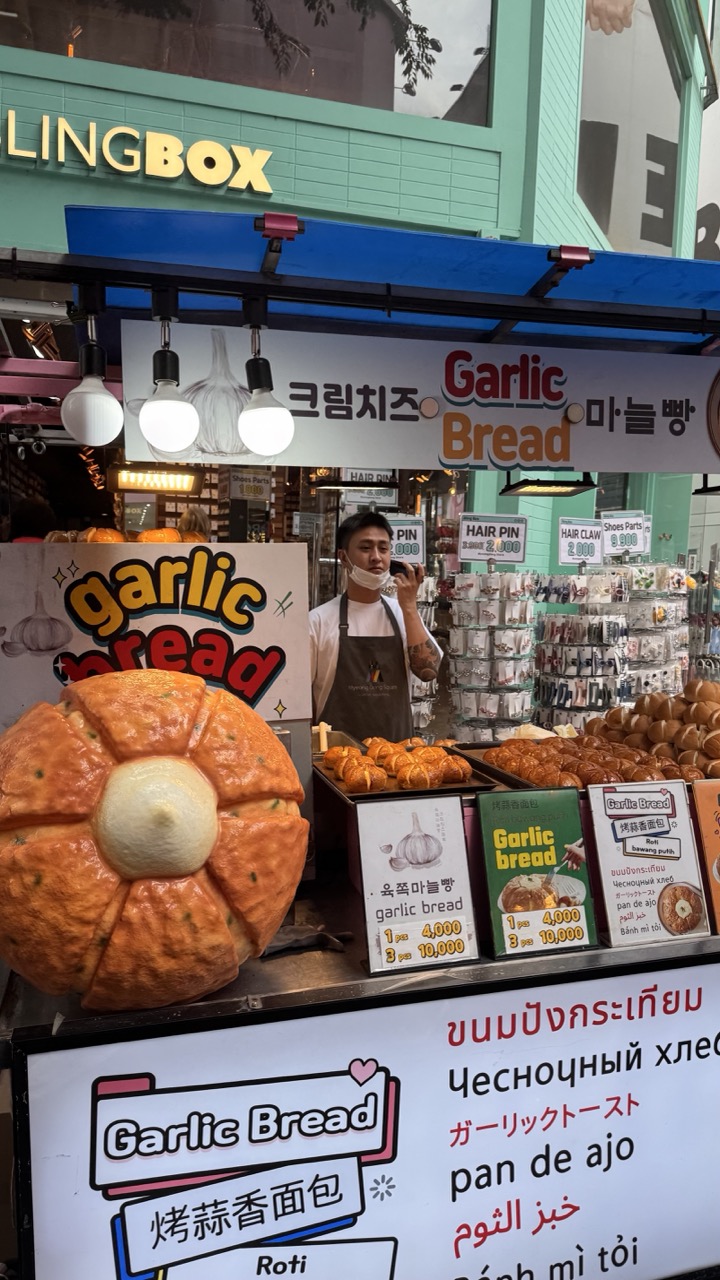

1. Overall Rating (0–10) — 6.0
This photograph captures the vibrant, chaotic energy of a street food stall with a playful, commercial flair. The oversized garlic bread prop and multilingual signage create a sense of global accessibility and whimsy, while the vendor’s casual presence adds a human touch. However, the image feels cluttered and slightly overexposed, diluting its visual impact and making it feel more like a snapshot than a carefully composed scene.
2. Composition (0–10) — 5.5
The frame is crowded with overlapping signs, objects, and text, creating visual noise that distracts from the central subject. The large garlic bread prop dominates the left side, pulling focus away from the vendor, who is slightly off-center and partially obscured.
3. Lighting (0–10) — 5.0
The lighting is flat and functional, likely from overhead fluorescent fixtures, which wash out color and reduce depth. While adequate for visibility, it lacks warmth or directionality, resulting in a sterile, commercial feel.
4. Color & Tone (0–10) — 5.5
The palette is dominated by bright, saturated yellows and reds from the signage, contrasted with muted browns and grays from the bread and background. The color choices are eye-catching but uneven, with a lack of tonal harmony that contributes to the visual clutter.
5. Creativity (0–10) — 6.5
The use of a giant garlic bread model and multilingual text adds a layer of playful cultural fusion, suggesting a story of globalization and street food innovation. While not artistically bold, the concept is clever and engaging.
6. Technical Quality (0–10) — 6.5
The image is sharp and well-focused, with clear details in the signage and bread. However, the composition and lighting choices limit its overall technical refinement.
7. Emotional Impact (0–10) — 5.5
The image evokes a sense of curiosity and mild amusement, particularly through the oversized prop and international signage. However, the overwhelming visual noise prevents a deeper emotional connection, leaving the viewer with a fleeting impression rather than a lasting resonance.
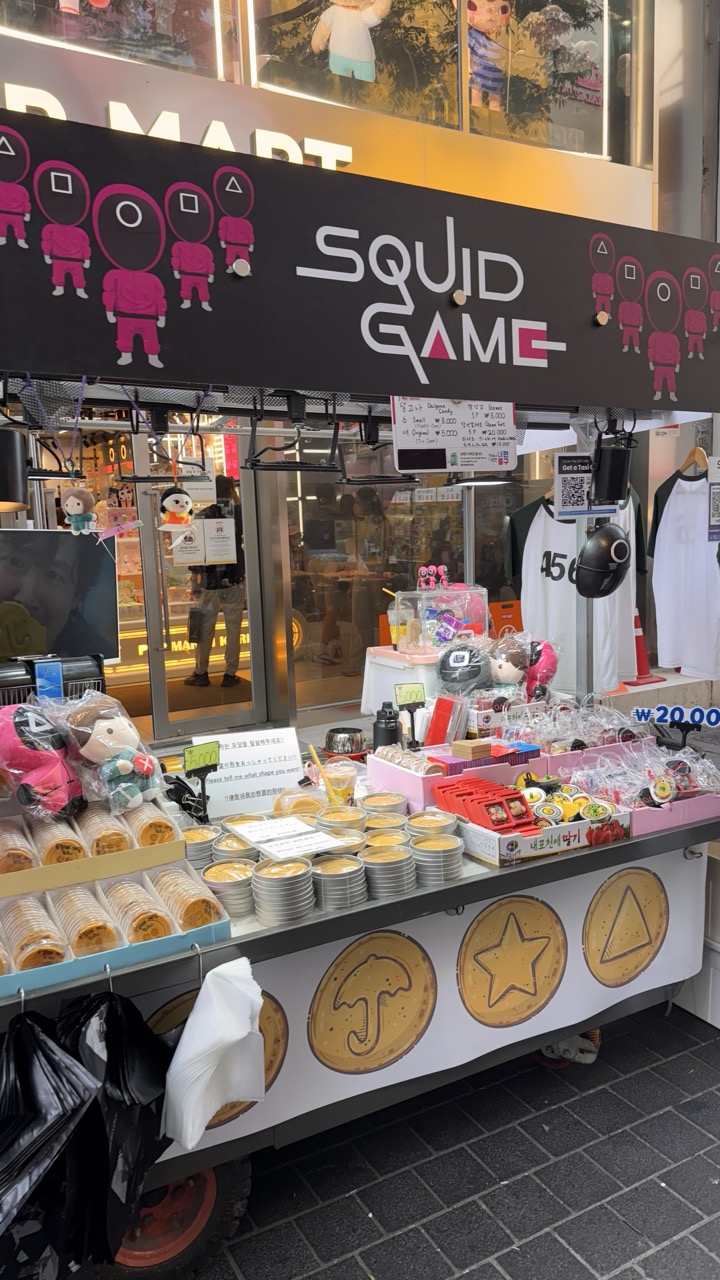

1. Overall Rating (0–10) — 6.0
This photograph captures the vibrant energy of a pop culture merchandise stall, centered on the global phenomenon of *Squid Game*. The scene is rich with thematic detail—costumes, symbols, and branded snacks—all layered into a visually dense urban tableau. While the image successfully conveys the commercial enthusiasm surrounding the series, its chaotic composition and flat lighting prevent it from achieving a more refined aesthetic, leaving it feeling more like a candid snapshot than a curated moment.
2. Composition (0–10) — 5.5
The frame is cluttered, with multiple layers of objects competing for attention. The low angle and wide perspective emphasize the abundance of merchandise, but the lack of a clear focal point or visual hierarchy weaken the overall balance.
3. Lighting (0–10) — 5.0
The lighting is mixed—bright, artificial illumination from overhead fixtures creates harsh reflections on the glass and plastic surfaces, while the surrounding ambient light is dim and uneven, resulting in a lack of tonal cohesion.
4. Color & Tone (0–10) — 6.0
The color palette is dominated by the bold black and white of the sign, punctuated by the vibrant pink of the *Squid Game* characters. However, the overall tone is slightly washed out, with muted saturation in the background and foreground elements, reducing the image's visual punch.
5. Creativity (0–10) — 7.0
The image captures a unique cultural moment with strong thematic intent, blending commercialism and fandom in a visually engaging way. The use of recognizable symbols and product placement reflects a clever narrative about modern pop culture’s commodification.
6. Technical Quality (0–10) — 6.5
The photo is sharp and clear, with good detail in the foreground objects. However, minor issues with focus and exposure in the reflections and background slightly diminish the technical polish.
7. Emotional Impact (0–10) — 5.5
The image evokes a sense of playful nostalgia and cultural curiosity, but the visual clutter and lack of emotional depth keep the viewer at a distance. It feels more like an observation than an emotional invitation.
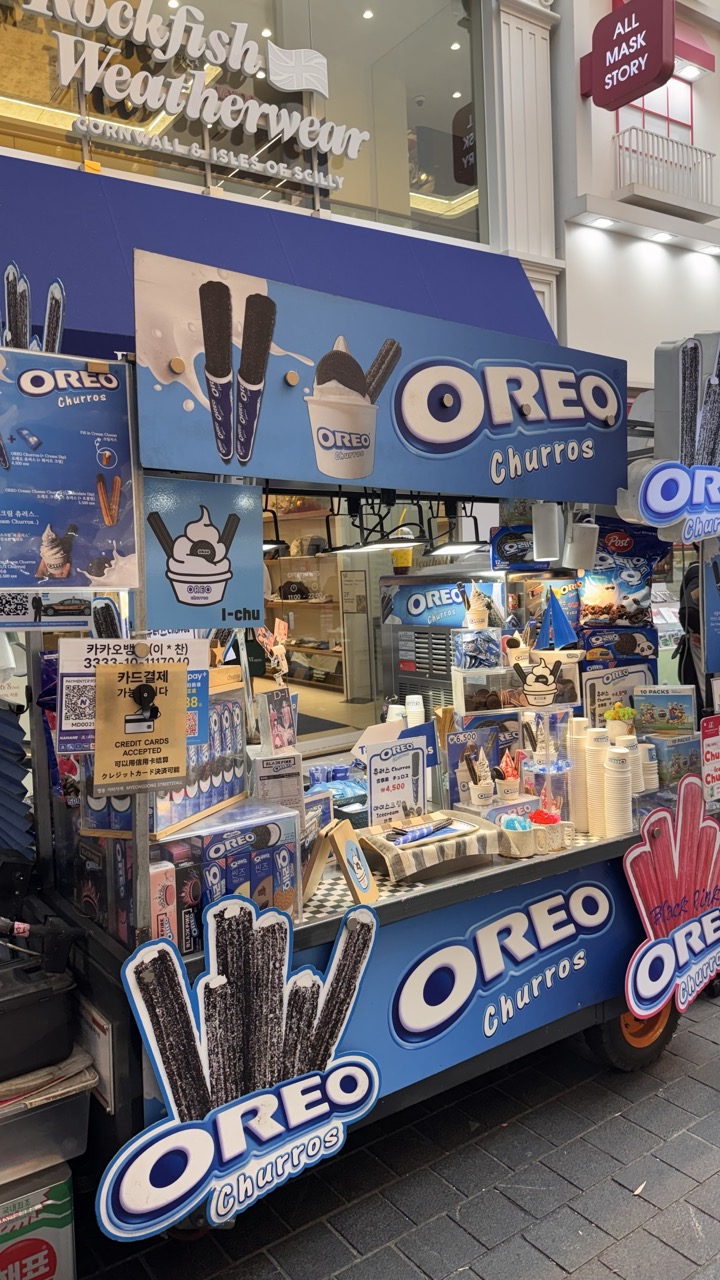

1. Overall Rating (0–10) — 6.0
This image captures the vibrant energy of a bustling street food stall, where the playful branding of Oreo Churros transforms a simple snack into a sensory spectacle. The composition is packed with visual noise—logos, signage, and product displays—that reflects the chaotic charm of a commercial marketplace, yet this abundance risks overwhelming the viewer. While the scene is clearly intended to be eye-catching, the lack of compositional restraint tempers its aesthetic impact.
2. Composition (0–10) — 5.5
The frame is densely packed with overlapping elements, creating a busy, cluttered feel. The low-angle perspective emphasizes the stall’s presence but sacrifices spatial clarity, with signage and product displays competing for attention.
3. Lighting (0–10) — 6.5
Bright, even lighting from overhead fixtures ensures clarity and visibility, enhancing the colors and details of the branding. However, the flat illumination lacks depth and fails to create dramatic contrast or mood.
4. Color & Tone (0–10) — 7.0
The dominant blue of the Oreo branding provides a strong visual anchor, while pops of white, red, and black create a high-contrast, energetic palette. The color choices are bold and effective, reinforcing the product's playful identity.
5. Creativity (0–10) — 6.5
The image successfully captures the commercial spectacle of a branded street food venture, leveraging repetition and scale to create a memorable visual. While not artistically groundbreaking, it effectively communicates the product’s appeal in a real-world context.
6. Technical Quality (0–10) — 7.5
The image is sharp and well-focused, with clear detail in both the signage and the products. The exposure is balanced, and there are no obvious technical flaws.
7. Emotional Impact (0–10) — 5.0
The scene evokes a sense of urban energy and consumer enthusiasm, but its overwhelming commercialism keeps the viewer at a distance. It feels more like an advertisement than an emotionally resonant moment.


1. Overall Rating (0–10) — 6.0
This photograph captures the vibrant energy of a Korean street food stall, where bold colors and playful branding create an immediate sense of place and flavor. The bright signage and appetizing display of cheese kimchi rolls draw the eye, while the cluttered arrangement reflects the authentic chaos of a busy market. Though the image is visually engaging, it lacks compositional restraint, with too much text and background distraction pulling focus from the food’s appeal.
2. Composition (0–10) — 5.5
The frame is crowded and slightly off-center, with competing elements—signage, traffic cones, and reflections—distracting from the main subject. A tighter crop and more deliberate framing would emphasize the food and the stall’s character.
3. Lighting (0–10) — 6.0
The lighting is functional and even, likely from overhead fluorescent sources, which illuminates the food clearly but flattens depth and shadow. The scene lacks atmospheric lighting, giving it a commercial, documentary feel rather than a dramatic or inviting mood.
4. Color & Tone (0–10) — 7.0
The warm yellow and red tones of the signage create a lively, energetic palette that matches the food’s bold flavors. While the color saturation is strong, the overall tone is somewhat flat, with muted contrast in the background reducing visual richness.
5. Creativity (0–10) — 6.5
The playful pig mascot and the stylized food display reflect a strong brand identity, adding whimsy and cultural context. However, the approach is conventional for street food photography, relying on recognizable tropes rather than unique visual storytelling.
6. Technical Quality (0–10) — 7.0
The image is sharp and clear, with good focus on the food and signage. The resolution and exposure are adequate, though some details are lost in the glare of the display lights and reflections.
7. Emotional Impact (0–10) — 6.0
The photograph evokes a sense of curiosity and appetite, inviting the viewer to imagine the taste and aroma of the rolls. While it captures the spirit of street food culture, it doesn’t fully convey the warmth or intimacy of the experience, leaving the viewer more as an observer than a participant.
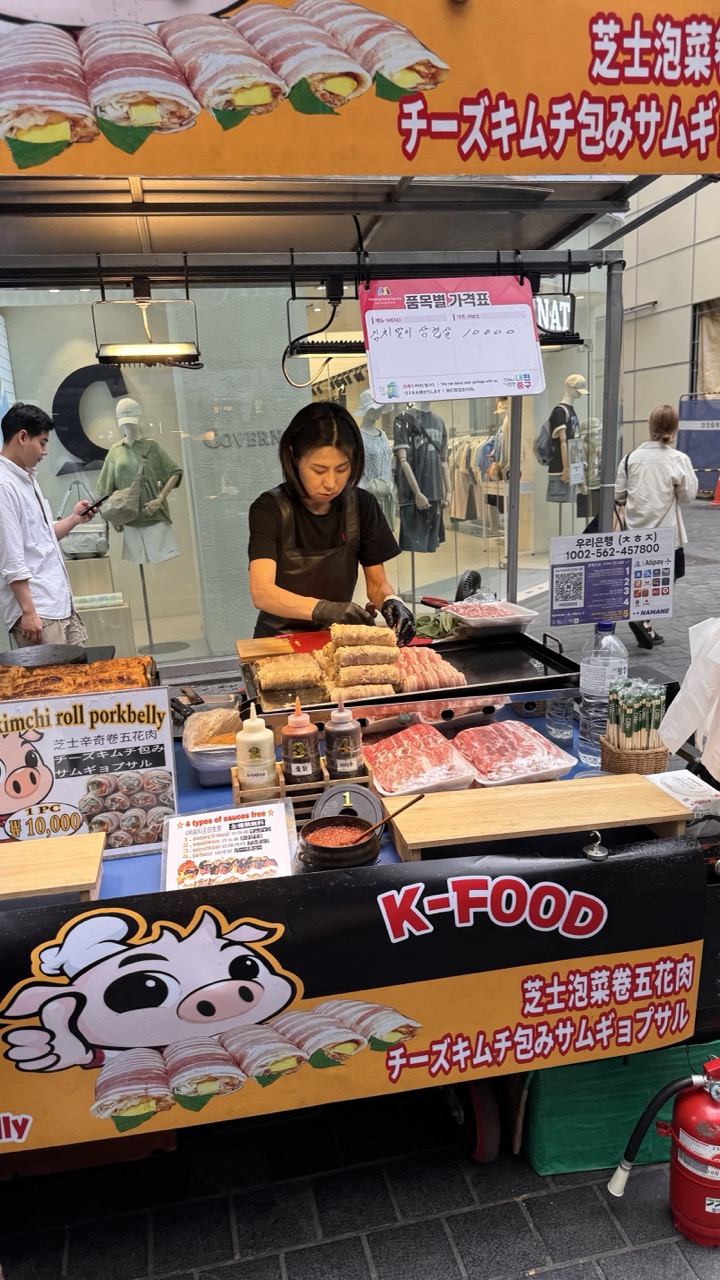

1. Overall Rating (0–10) — 6.8
This image captures the vibrant energy of a Korean street food stall with a clear sense of place and authenticity. The vendor’s focused posture and the colorful signage convey a lively urban scene, though the composition feels slightly cluttered, reducing the visual impact. While the scene is rich in detail and cultural context, the lack of a strong focal point and overabundance of text slightly dilute the aesthetic cohesion.
2. Composition (0–10) — 6.0
The frame includes too many elements—signs, people, and background distractions—pulling attention away from the central subject. A tighter crop would better emphasize the vendor and her craft.
3. Lighting (0–10) — 6.5
Natural daylight illuminates the scene evenly, but the overhead fluorescent light casts a slightly harsh tone. The balance between ambient and artificial light creates a functional but unremarkable mood.
4. Color & Tone (0–10) — 7.0
The bright reds and yellows of the signage create a bold contrast against the muted pavement and clothing, drawing the eye. The color palette is lively and energetic, reflecting the street food atmosphere.
5. Creativity (0–10) — 6.5
The image successfully documents a moment in everyday life with a playful touch in the cartoon branding. However, it leans more toward observational documentation than artistic interpretation.
6. Technical Quality (0–10) — 7.5
The image is sharp and clear, with good detail in the food, signage, and textures. Focus is consistent, and exposure is well-managed despite the mixed lighting.
7. Emotional Impact (0–10) — 6.0
The scene feels authentic and grounded, evoking a sense of curiosity and warmth. Yet, the lack of emotional depth or narrative focus keeps the viewer from fully connecting with the moment.
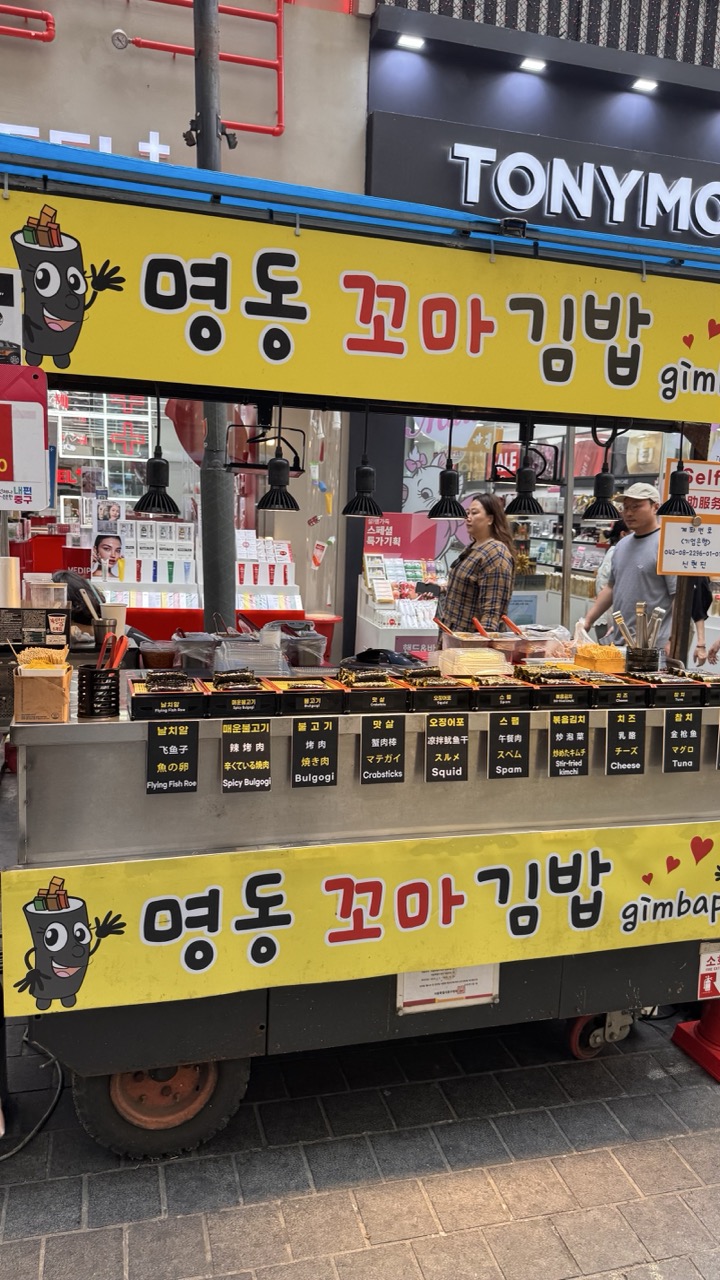

1. Overall Rating (0–10) — 6.0
This image captures the vibrant energy of a Korean street food stall, brimming with cultural authenticity and everyday charm. The bright yellow signage and neatly labeled menu items create a lively, inviting atmosphere, while the bustling background adds a sense of real-world context. However, the composition feels slightly cluttered and lacks a strong focal point, preventing the image from achieving a more polished, artistic impact.
2. Composition (0–10) — 5.5
The frame is wide, capturing the full breadth of the food cart and its surroundings, but this results in a busy, unbalanced arrangement. The subject—the food stall—is centered, yet the visual weight of the background elements and the uneven placement of signage disrupts harmony.
3. Lighting (0–10) — 6.0
The scene is illuminated by a mix of overhead artificial lights and ambient daylight, creating a functional but flat lighting scheme. While the brightness highlights the details of the menu and food, it lacks depth and contrast, diminishing the moodiness of the urban setting.
4. Color & Tone (0–10) — 7.0
The dominant yellow of the signage creates a bold, cheerful tone, complemented by the contrasting black and red lettering. The colors are vibrant and culturally resonant, though the overall palette leans slightly toward the mundane due to the lack of tonal variation.
5. Creativity (0–10) — 6.5
The use of a cartoon mascot and bilingual signage adds a playful, accessible quality, grounding the image in local culture. The concept is straightforward and effective, but it doesn’t push beyond typical street photography into more conceptual or expressive territory.
6. Technical Quality (0–10) — 7.5
The image is sharp and well-focused, with clean details visible in the food labels and surrounding objects. The exposure is balanced, and there’s no noticeable noise or distortion, indicating strong technical execution.
7. Emotional Impact (0–10) — 6.0
The photograph evokes a sense of curiosity and familiarity—its charm lies in its authenticity and everyday realism. While it captures the spirit of street life, it doesn’t deeply stir emotion or create a lasting impression, feeling more like a snapshot than a powerful narrative.
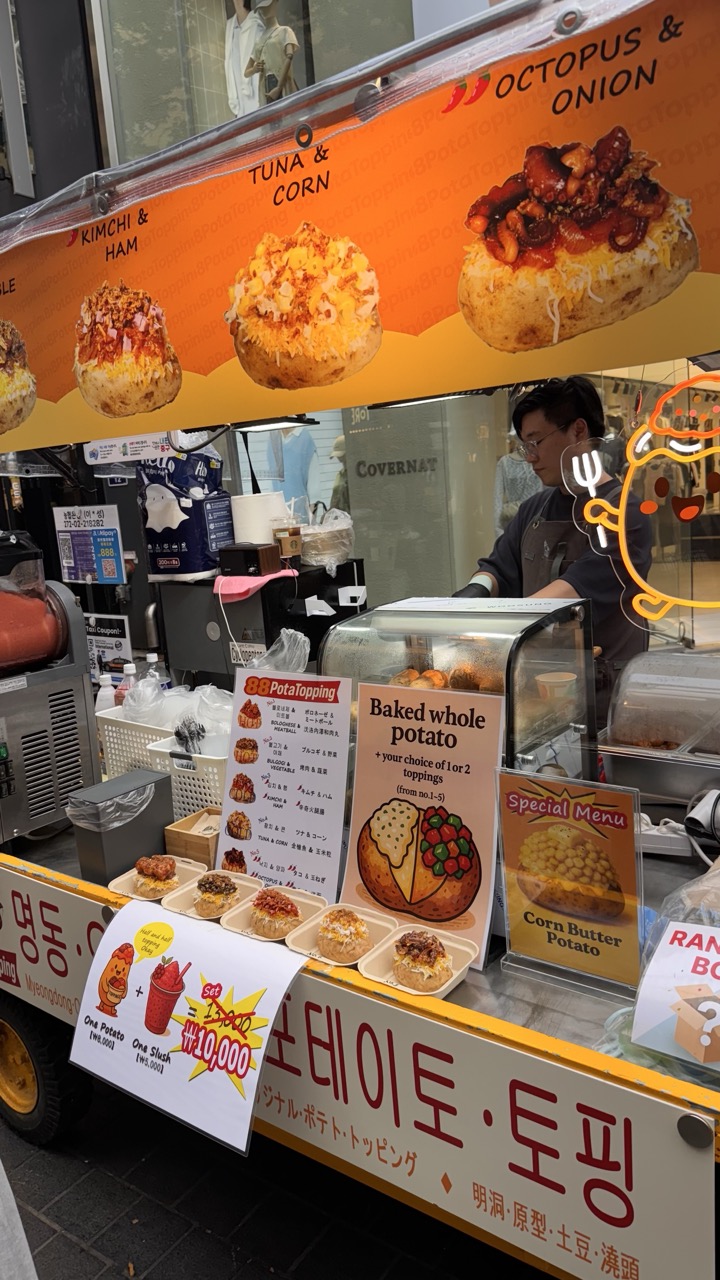

1. Overall Rating (0–10) — 6.0
This image captures the vibrant energy of a Korean street food stall with a strong sense of authenticity and culinary detail. The bright signage and array of toppings create a visually engaging scene, though the cluttered composition slightly undermines its clarity. While the image effectively conveys the lively atmosphere of a bustling market, the lack of a clear focal point and overexposure in certain areas prevent it from achieving a more refined aesthetic.
2. Composition (0–10) — 5.5
The frame is densely packed with elements, creating a busy scene that distracts from a central subject. The vendor is positioned off-center, and the overlapping signs and objects create visual noise, reducing compositional harmony.
3. Lighting (0–10) — 6.0
Natural daylight illuminates the scene, but the bright overhead light causes some glare on the signage and reflective surfaces. The lighting is functional but lacks subtlety, with harsh highlights reducing tonal depth.
4. Color & Tone (0–10) — 7.0
The warm orange and yellow tones of the signage create an inviting, energetic mood, while the pops of red and green in the food photos add vibrancy. However, the color balance is slightly unbalanced, with some areas appearing oversaturated.
5. Creativity (0–10) — 6.5
The image successfully captures the essence of street food culture with its lively presentation and playful signage. The inclusion of both Korean and English text adds cultural context, though the execution leans more toward documentation than artistic interpretation.
6. Technical Quality (0–10) — 6.5
The image is sharp and detailed, with clear text and textures visible. However, some areas suffer from overexposure and minor focus inconsistencies, particularly in the background.
7. Emotional Impact (0–10) — 6.0
The scene evokes a sense of excitement and indulgence, tapping into the universal appeal of street food. While it captures the energy of the moment, the visual clutter keeps the emotional resonance from fully resonating with the viewer.
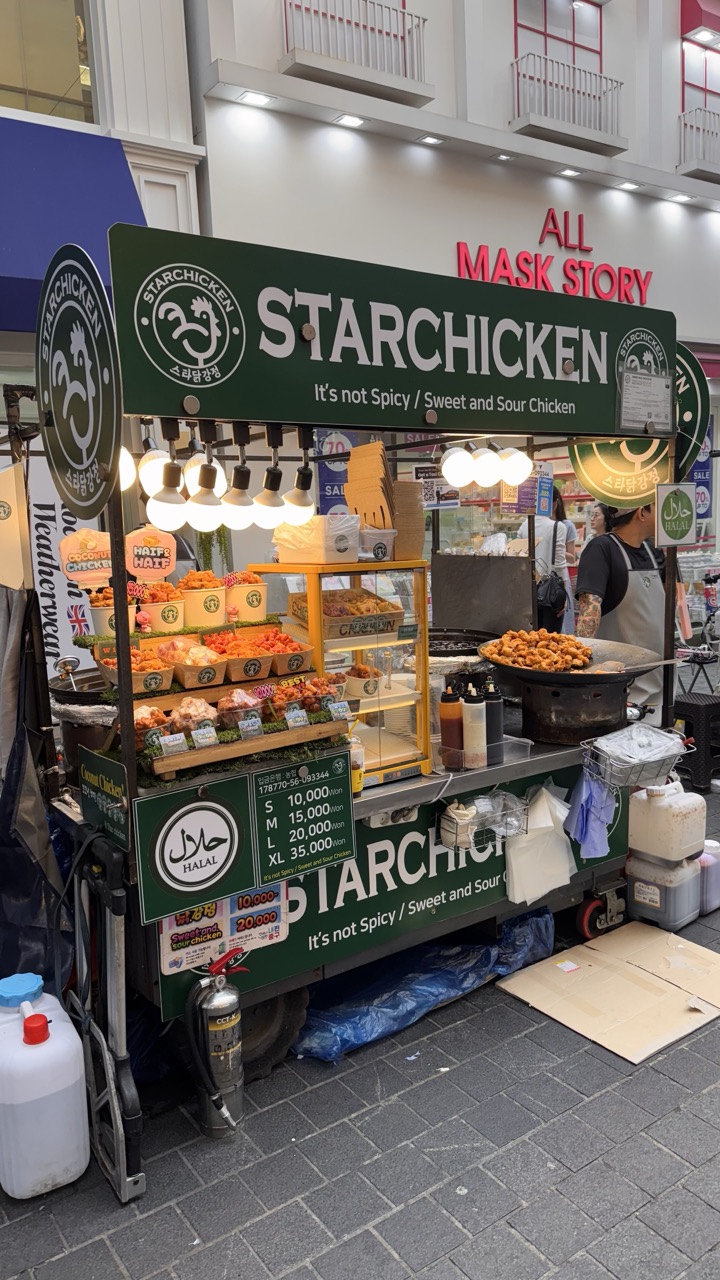

1. Overall Rating (0–10) — 6.0
This photograph captures the vibrant energy of a street food stall in a bustling commercial area, where the colorful signage and array of fried chicken varieties invite curiosity. While the scene is rich with detail and cultural context, the composition feels slightly cluttered, and the lighting lacks a cohesive mood. The image succeeds as a documentary snapshot of urban food culture but falls short of cinematic or artistic distinction.
2. Composition (0–10) — 5.5
The framing includes too much peripheral detail, pulling focus from the central stall. The diagonal angle and overlapping elements create visual noise, though the subject remains identifiable.
3. Lighting (0–10) — 6.0
Harsh overhead lighting from the stall’s bulbs and surrounding storefronts flattens shadows and washes out textures. While functional for visibility, it diminishes atmospheric depth.
4. Color & Tone (0–10) — 6.5
The green signage and golden fried chicken provide a warm, appetizing contrast against the neutral pavement and white building. However, the color palette is dominated by artificial tones, reducing visual harmony.
5. Creativity (0–10) — 6.0
The image captures an authentic moment of street food life with a clear cultural identity, but the approach is straightforward and lacks a unique visual interpretation.
6. Technical Quality (0–10) — 7.0
The image is sharp and well-exposed, with clean details in the signage and food display. Focus is consistent across the frame, though some minor distractions are present.
7. Emotional Impact (0–10) — 5.5
The photograph evokes a sense of everyday life and culinary diversity, but it remains observational rather than deeply engaging. The viewer is shown the scene but not invited into its emotional core.


1. Overall Rating (0–10) — 5.5
This photograph captures a candid moment in a bustling urban marketplace, where the juxtaposition of a skincare brand and a street food stall creates a layered, slice-of-life narrative. The "ALL MASK STORY" signage and the adjacent "Steak / 烤肉" cart offer a glimpse into the commercial vibrancy of the location, but the image feels cluttered and slightly disorienting, with too many competing visual elements. While the scene is authentic and full of cultural context, the lack of focus and compositional clarity keeps it from feeling cohesive or impactful.
2. Composition (0–10) — 5.0
The framing is awkward, with the foreground figure partially obstructing the view and the background elements overlapping without clear hierarchy. The subject is off-center, and the depth of field fails to guide the eye effectively, resulting in a busy, unbalanced composition.
3. Lighting (0–10) — 6.0
The scene is lit by bright, overhead fluorescent lights, which create a flat, even illumination but lack warmth or atmospheric quality. The reflections on the glass storefront and the harsh glare on signage slightly detract from the overall visual harmony.
4. Color & Tone (0–10) — 5.5
The dominant reds of the signage and food cart contrast with the neutral tones of the pavement and clothing, creating a visually active palette. However, the colors feel somewhat artificial and over-saturated, reducing the image’s natural appeal and emotional resonance.
5. Creativity (0–10) — 6.0
The image succeeds in capturing a real, unposed moment, blending commercial culture with everyday life in an interesting way. However, the creative potential is undermined by the lack of intentional framing or narrative focus, leaving it more observational than expressive.
6. Technical Quality (0–10) — 7.0
The image is sharp and clear, with good detail in the signage and textures. The focus is adequate, though the shallow depth of field fails to isolate the subject, contributing to the visual clutter.
7. Emotional Impact (0–10) — 5.0
The photograph conveys a sense of urban energy and commercial density, but the emotional connection is muted. The viewer is positioned as a passive observer rather than being drawn into a personal or reflective moment, limiting the image’s ability to resonate deeply.
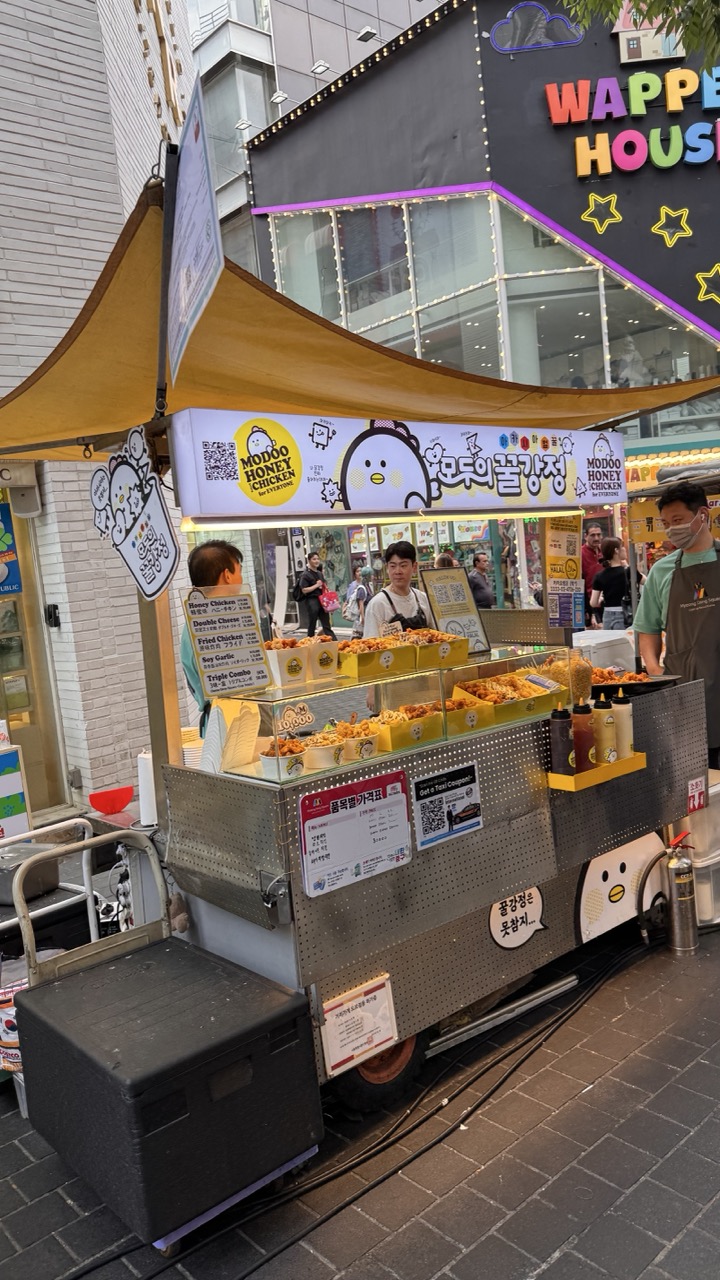

1. Overall Rating (0–10) — 6.0
This photograph captures the lively energy of a street food vendor in a bustling urban setting, where the bright branding and array of fried chicken dishes draw the eye. While the scene is rich with cultural detail and a sense of movement, the composition feels slightly cluttered and the lighting lacks dramatic depth, resulting in a snapshot that is more documentary than evocative. A more deliberate framing and lighting approach could elevate the image from a casual street scene to a compelling visual narrative.
2. Composition (0–10) — 5.5
The subject is centered but competes with surrounding elements like the building facade and passersby, creating visual distraction. A tighter crop would enhance focus on the food stall and its vendors.
3. Lighting (0–10) — 5.0
Natural daylight provides even illumination, but the lack of directional light or shadows gives the image a flat, transactional feel, diminishing atmospheric depth.
4. Color & Tone (0–10) — 6.5
The bright, playful colors of the vendor’s signage—particularly the yellow and purple—stand out against the neutral urban backdrop, creating visual interest. However, the overall palette is slightly oversaturated, lending a commercial tone.
5. Creativity (0–10) — 6.0
The image successfully captures a slice of contemporary street culture, with the animated branding adding a whimsical touch. However, the approach is more observational than artistically inventive.
6. Technical Quality (0–10) — 7.0
The image is sharp and clear, with good detail in the food display and signage. Focus is consistent across the frame, though some background elements are slightly overexposed.
7. Emotional Impact (0–10) — 5.5
The scene conveys a sense of everyday life and urban vibrancy, but the lack of human connection or narrative tension keeps the emotional resonance subdued. It invites curiosity rather than deep engagement.
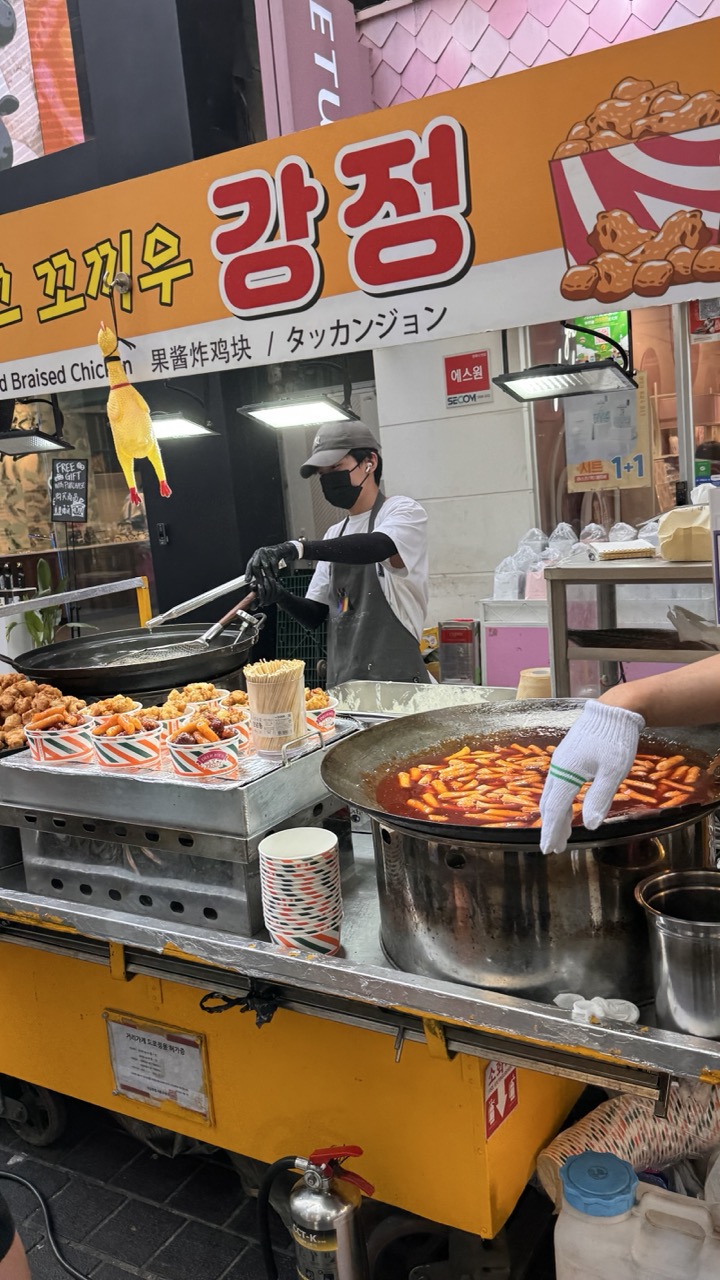

1. Overall Rating (0–10) — 7.0
This image captures the vibrant energy of a Korean street food stall with dynamic action and rich cultural detail. The scene feels alive, with the vendor actively preparing tteokbokki and fried chicken, while the bold signage and colorful food create an inviting atmosphere. The composition is slightly cluttered, but the visual storytelling and authenticity give it strong appeal. A more balanced framing and stronger lighting contrast would elevate its artistic impact.
2. Composition (0–10) — 6.5
The frame is slightly off-center, with the vendor positioned to the left and the tteokbokki pot dominating the right, creating an uneven balance. The foreground elements, such as the fire extinguisher and containers, add visual noise, while the depth of field is shallow, drawing focus to the middle ground. A tighter crop would improve focus and reduce distractions.
3. Lighting (0–10) — 6.0
The lighting is a mix of overhead fluorescent and ambient daylight, creating a flat, functional illumination that highlights the food but lacks atmospheric depth. The bright sign and reflective surfaces cause some overexposure, while shadows in the background reduce detail. The light is adequate for documentation but does not enhance mood or drama.
4. Color & Tone (0–10) — 7.5
The palette is rich and engaging, with the reds of the tteokbokki and sign contrasting against the yellow cart and white gloves. The colors are vibrant and saturated, emphasizing the appetizing nature of the food. The tone is warm and inviting, though some areas appear slightly washed out due to the lighting.
5. Creativity (0–10) — 7.0
The image effectively captures the essence of Korean street food culture, with strong visual cues like the Korean signage, tteokbokki, and fried chicken. The inclusion of the vendor in motion adds narrative depth, and the composition suggests a moment of real-time activity. While not groundbreaking in concept, it succeeds in portraying an authentic, lively scene.
6. Technical Quality (0–10) — 7.0
The image is sharp and well-focused on the central action, with clear details in the food and signage. The exposure is generally balanced, though some highlights are blown out. There’s no significant noise or blur, and the camera seems to have captured the moment cleanly, suggesting good technical execution.
7. Emotional Impact (0–10) — 7.5
The photograph evokes a sense of excitement and sensory indulgence, capturing the buzz of a busy street food scene. The viewer can almost smell the spices and hear the sizzle of the wok. The authenticity and cultural specificity create a strong emotional connection, especially for those familiar with Korean cuisine, making it both relatable and engaging.
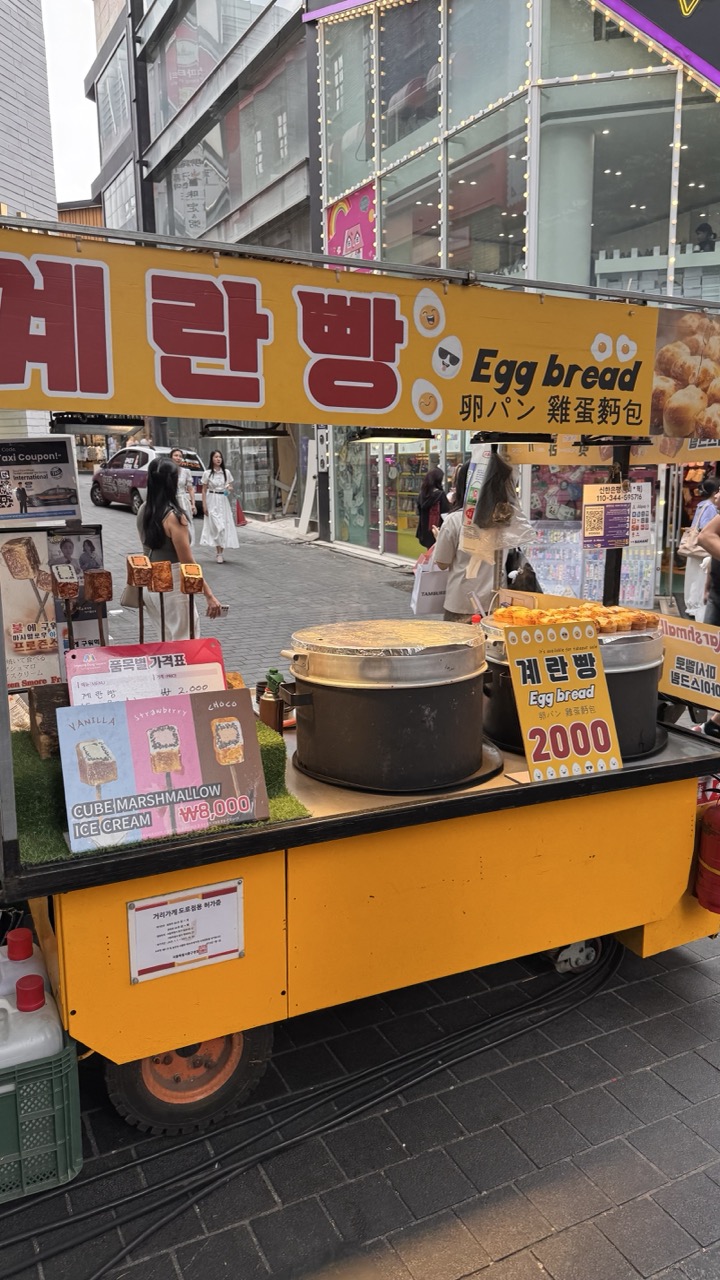

1. Overall Rating (0–10) — 6.0
This image captures the vibrant energy of a Korean street food scene, where the bright yellow cart and bold signage draw the eye amid a bustling urban backdrop. While the composition effectively conveys the atmosphere of a lively city street, the cluttered arrangement and flat lighting reduce its visual impact. The scene feels more like a snapshot of daily life than a polished photograph, yet it retains a certain charm in its candid authenticity.
2. Composition (0–10) — 6.0
The central placement of the food cart provides a clear focal point, but the surrounding elements—people, signage, and background buildings—create visual noise that dilutes focus. A more deliberate framing could enhance the narrative clarity.
3. Lighting (0–10) — 5.5
Natural daylight evenly illuminates the scene, but the overcast sky results in flat, diffused light that lacks contrast and depth. The lack of strong shadows diminishes the visual drama.
4. Color & Tone (0–10) — 6.5
The bright yellow of the cart stands out against the muted urban tones, creating a visually engaging contrast. The use of red and white in the signage adds energy, though the overall palette feels slightly washed out.
5. Creativity (0–10) — 6.0
The photograph captures a moment of everyday culture with a sense of place, but the approach is straightforward and observational rather than artistically inventive. The multilingual signage and mix of Korean and English add cultural texture.
6. Technical Quality (0–10) — 7.0
The image is sharp and detailed, with clear focus on the cart and signage. The exposure is balanced, and there are no obvious technical flaws, though the composition limits its aesthetic potential.
7. Emotional Impact (0–10) — 5.5
The image evokes a sense of urban vitality and street-level charm, but the lack of emotional depth or human connection keeps the viewer at a distance. It feels more like documentation than storytelling.
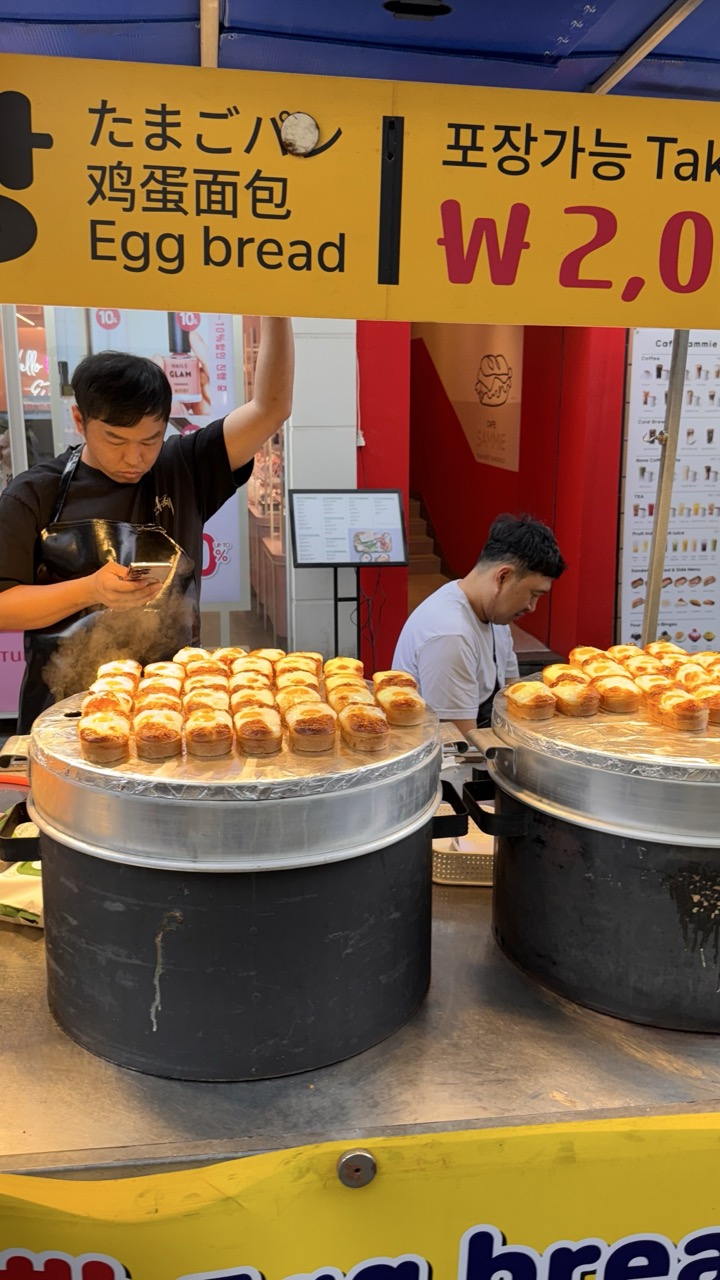

1. Overall Rating (0–10) — 6.0
This photograph captures the vibrant energy of a street food stall, where the sizzle of cooking egg bread and the focused labor of vendors create a compelling sense of immediacy. The bright signage and steaming trays draw the eye, but the composition feels slightly cluttered, with competing elements that distract from the central action. While the scene is rich with cultural detail and sensory promise, the image lacks the visual refinement to feel fully polished—its strength lies in authenticity rather than aesthetic control.
2. Composition (0–10) — 5.5
The framing is slightly off-center, with the vendor on the left and a second worker on the right creating an uneven balance. The large pots dominate the lower half, partially obscuring the base of the sign and creating visual weight that pulls focus away from the human subjects.
3. Lighting (0–10) — 6.0
Natural daylight illuminates the scene evenly, with a soft glow on the golden tops of the bread. The steam adds texture and depth, and while the light is functional, it lacks dramatic contrast or mood, resulting in a straightforward documentary feel.
4. Color & Tone (0–10) — 6.5
The yellow signage provides a bold, warm anchor, complementing the golden-brown tones of the bread. The red backdrop and black pots create strong contrast, but the overall palette leans slightly flat, with muted mid-tones that reduce vibrancy.
5. Creativity (0–10) — 6.0
The image successfully captures a moment of everyday life with cultural specificity, using familiar street food imagery to tell a story of labor and tradition. However, it doesn’t break new visual ground—its appeal is observational rather than conceptual.
6. Technical Quality (0–10) — 7.0
The focus is sharp on the bread and the vendor, with clear detail throughout. The image is well-exposed, and the steam adds a layer of atmospheric interest, though the background is slightly overexposed in places.
7. Emotional Impact (0–10) — 6.0
There’s a quiet dignity in the vendor’s concentration and the rhythm of the food preparation, evoking a sense of community and tradition. The viewer is drawn into the scene, but the emotional resonance remains restrained by the lack of a clear focal point or narrative closure.
Loading map...